growth?
How can we improve quality of life in third world countries?
oil spills affect ecosystems and natural renewable resources?
What would curb the childhood obesity
How can we have a sustainable energy future?
Research, scholarship and creative activity at Oklahoma State University 2013
What caused the extinction of the dinosaurs?
customer service impact consumer buying decisions?
brain development?
world?
What’s the best way to store renewable energy once we produce it?
How can crops survive historic droughts?
Are stem cells the answer to preventing human diseases?
Can we make fuel less corrosive?
something?
car?
state?
be?
what
What new computer
What does medieval art tell us about ancient cultures?
How does maternal nutrition impact infant brain
Are there better ways to
sun?
development cause climate change?
What could keep cattle healthier?
there predictors for economic failure?
Can we make plants pest resistant?
How can we improve gene therapy?
caused our current economic recession?
have a sustainable energy future?
art tell us about ancient cultures?
Can we engineer more disease-resistant
What causes heart disease? certain animals sniff out bombs?
What new building materials
Do certain foods prevent Can osteoporosis be reversed?
What are the best catalysts
What are the best catalysts for economic growth?
for cancer?
Can osteoporosis be reversed?
sustainable energy future?
How do oil spills affect ecosystems
How did religion spread across
What new computer programs could benefit business forecasters?
conner? world?
countries?
Did urban development cause
What’s the best way to store
when
Are there
Can renewable energies provide all the power we need? how
is it
what
Are there better ways to predict natural disasters?
What causes abnormal fat storage that leads to obesity would curb the childhood obesity epidemic?
How can we improve cancer treatment?
Could new traffic control devices enhance pedestrian and vehicular
Do certain foods prevent disease?
How can we make our country safer and more secure?
How does STEM education prepare our children for success?
there better ways to detect and monitor dangerous corrosion on bridges?
Are there better ways to protect ourselves from identity theft?
What new building materials would make structures sounder?
leads to obesity and diabetes?
less corrosive?
pedestrian and vehicular safety? safety?
Can certain animals sniff out
What caused the extinction of
Could new traffic
What causes genes to mutate? genes to mutate?
What causes abnormal fat storage that leads to obesity and diabetes? Are there predictors for economic failure?
Can we engineer more disease-resistant plants?
How can we
are there
What caused
Are stem cells
How can crops survive
Are there biomarkers in our genes for
Can we produce ethanol from something other than corn?
we prevent premature deterioration of highways, runways, parking lots and bridges?
How can we improve quality
customer service impact consumer
Does
Burns Hargis, President
Stephen W.S. McKeever, Vice President for Research and Technology Transfer
Vanguard is published annually by Oklahoma State University. It is produced by the Office of Vice President for Research and Technology Transfer.
Editor/Writer: Kelly Green, Art Director/Designer: Ross Maute,
Photographers: Rebecca Bailey, Todd Johnson, Gary Lawson, Kevin McCroskey, Phil Shockley
Contributing Writers: Rebecca Bailey, Wravenna Bloomberg, Laura Crutcher, Matt Elliott, Sean Kennedy, Christy Lang, David Purdie, Lorene A. Roberson, Dr. Betty Simkins, Paige Vandaveer
For details about research work highlighted in this magazine or reproduction permission, contact the editor.
Kelly Green, Editor, Vanguard 405.744.5827; vpr@okstate.edu research.okstate.edu
Greetings friends and colleagues,
Merriam-Webster’s online dictionary defines “solution”
as 1) the action or process of solving a problem and as 2) an answer to a problem. If you couldn’t tell by the cover of this magazine, there are a lot of questions still unanswered in our society: How are we going to meet future energy demands?
How early can we detect cancer? Can we engineer crops capable of surviving historic droughts?

How can our economy be more competitive? Are there better ways to predict natural disasters? How can we make our country safer and more secure? And these are only the tip of the iceberg!
The needs and issues of our society are great, but here at OSU our passion to solve them is greater.
Our faculty and student researchers are motivated by questions that still have no answer. They dedicate themselves to the process of finding solutions. It’s central to who they are as scientists, humanitarians, community leaders, doctors, engineers and citizens, and it reflects the value and tradition of OSU’s land-grant mission.
I hope as you read the stories in this issue of Vanguard you catch a glimpse of that process and of the all the problems we are tackling as a university. There will always be more questions to answer, but that’s OK. That’s what research is all about.
Sincerely,

You’ve got questions? We’ve got research.
Scan this code for a video on how OSU research is answering questions, solving problems and meeting needs.
The video is also available at ostate.tv/topics/research

Oklahoma State University, in compliance with Title VI and VII of the Civil Rights Act of 1964, Executive Order 11246 as amended, Title IX of the Education Amendments of 1972, Americans with Disabilities Act of 1990, and other federal laws and regulations, does not discriminate on the basis of race, color, national origin, sex, age, religion, disability, or status as a veteran in any of its policies, practices or procedures. This includes but is not limited to admissions, employment, financial aid, and educational services. Title IX of the Education Amendments and Oklahoma State University policy prohibit discrimination in the provision of services or benefits offered by the University based on gender. Any person (student, faculty or staff) who believes that discriminatory practices have been engaged in based upon gender may discuss their concerns and file informal or formal complaints of possible violations of Title IX with the OSU Director of Affirmative Action, 408 Whitehurst, Oklahoma State University, Stillwater, OK 74078, (405)744-5371 or (405) 744-5576 (fax). This publication, issued by Oklahoma State University as authorized by the Vice President for Research and Technology Transfer, was printed by Southwestern Stationery and Bank Supply at a cost of $5,180. (5M) 12/12. #4467
Research at Oklahoma State University • www.research.okstate.edu
2 Q&A: Promise in the Skies
4 The Learning World of Tomorrow
Researchers in the College of Engineering, Architecture & Technology are using virtual reality environments to help children with autism learn science.
6 The Power of a Protein
Polycystic kidney disease, a common, life-threatening genetic disease, is the focus of research at the Center for Veterinary Health Sciences.
10 Carwash for Meat
13 The Power of PR
16 A Model for Student Growth
18 Native American Health and Well-being
20 Balancing Act
Executive pay is a big, big deal. Not just because it’s serious money, but because of how it affects who receives it. Ali Nejadmalayeri, an OSU assistant finance professor, had his study on executive compensation published in the Journal of Corporate Finance
22 Protecting the Troops
OSU-Tulsa associate professor Jay Hanan is leading research to create a stronger, lighter body armor that could be used in combat.
24 A Smart Garment for a Healthy Future
An interdisciplinary team at OSU’s Center for Health Sciences has created a garment that could revolutionize the treatment of cardiovascular and respiratory diseases and disorders.
26 Physics + Medicine = Success
28 The Energy Renaissance and U.S. Energy Policy
In this column, finance professor Betty Simkins presents five energy realities and offers insight on how energy policies should be adapted to address them.


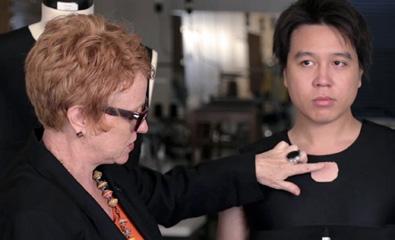

Possibilities in
30 The
Plants
the Numbers
COVER Images Frozen in Time
OF CONTENTS
2013 4 18 24 28 1 Research at Oklahoma State University • www.research.okstate.edu
32 Yan receives 2012 Whatley Award 33 Growing
BACK
TABLE
Research, scholarship and creative activity at Oklahoma State University
Q A&
Promise in the Skies
Unmanned aerial systems are a hot topic right now at OSU and throughout the state. Dave Wagie, the director of aerospace and defense economic development at the Oklahoma Department of Commerce, sheds light on why this burgeoning industry should have a home in Oklahoma.
About two years ago, the state of Oklahoma, including Gov. Mary Fallin, seemed to rally around unmanned aerial systems as an economic driver for the future of our state. Why is supporting and developing the UAS industry such a win for Oklahoma?
The UAS industry is the major future expansion area in aerospace, and Oklahoma is perfectly suited to be an international leader in this area. First, Oklahoma has always been an “aerospace state.” Clyde Cessna flew his first airplane in Oklahoma in 1913, and Wiley Post set a round-the-world solo flight record in 1933. Today, aerospace is 10 percent of the Oklahoma economy: 500 companies, 150,000 workers, $5 billion in payroll, and $12.5 billion of

annual output. We have a huge aerospace focus in the state – from military (with Tinker, Vance and Altus Air Force bases), to the 500-plus aerospace companies in the state, to the largest military maintenance depot (Tinker AFB) in the U.S., and the largest civilian depot in the world (American Airlines). In addition, we have the FAA Mike Monroney Aeronautical Center, the largest FAA training location in the U.S. outside of Washington, D.C..
The UAS industry will be exploding in the next few years. The world market in UAS is $5.9 billion this year, growing to $15.1 billion by 2022. The U.S. Department of Defense spent $3.9 billion on UAS in 2011 and will spend $5.5 billion by 2025. There are 1,300 different UAVs currently being tested or manufactured worldwide. Estimates
are that 50,000 new jobs will be created by 2015 in UAS – and Oklahoma plans to be a major part of this growth.
Many countries already use UAS, and the U.S. will soon be using them nationwide after the FAA starts opening up national airspace to UAS in 2015. We believe the UAS industry will explode in the U.S. after 2015 for first responders, fire, police; agriculture, ranching; inspecting rail lines, oil and gas lines and stacks, wind turbines, environmental areas; communication; security, etc.
In what ways is Oklahoma set apart to be a worldwide leader in UAS?
Oklahoma is becoming a world leader in UAS and a strong competitor for one of the six national test ranges
PHOTO PROVIDED 2 Research at Oklahoma State University • www.research.okstate.edu
the FAA will be selecting in the coming months – both because of our aerospace industry in the state and because we are already researching, developing and testing all areas of the UAS industry: the vehicles (planes), the payloads/sensors (cameras, IR, weather radar, etc.), the communication/avionics/electronics/ navigation equipment, the ground station equipment, the testing resources and equipment (flight and ground), and training and education for UAS engineers, pilots, payload operators, maintenance personnel, etc. We have 14 companies in the state that are already specifically focused on the UAS industry.
We are also set apart for two other major UAS resources. First, through OSU’s University Multispectral Laboratories, we have our UAS flight test facility in Lawton, where we have been flying and testing UAVs and their payloads and sensors for two years, under a unique agreement with Fort Sill to use a section of its military restricted airspace exclusively for UAS flight testing. Second, at OSU, we have the first UAS graduate program in the nation, contributing to research and development on UAVs.
Finally, we are set apart because we are taking a statewide approach to developing the UAS industry in Oklahoma. In August 2011, Gov. Fallin created the Oklahoma UAS Advisory Council to help develop the UAS industry. This council is chaired by Stephen McKeever, the VP for Research at OSU, and has members from OSU, OU, state agencies and private companies. Having a statewide approach means Oklahoma can bring all our resources – public and private – to bear to effectively grow our UAS industry and be competitive to attract companies and federal agencies to test, invest and grow here in the future.
In what ways do the educational and research capabilities available at OSU support the statewide UAS initiative?
OSU is a critical part of the growth of the UAS industry in Oklahoma. In the Mechanical and Aerospace Engineering School, students have been designing and building UAVs for years, flying
them under radio-controlled aircraft rules. Now the department has added the first graduate option in UAS in the country, enrolling the first 20 graduate students in January 2012. These graduate students and their faculty will be researching, developing and testing new UAV aircraft that will support the UAS industry in the state and make us even more competitive for selection as an FAA national UAS test range.
Oklahoma was recently selected by the Department of Homeland Security as a test site for the DHS Robotic Aircraft for Public Safety (RAPS) Program. What does this selection mean for the state?
This was a huge plus for Oklahoma and our UAS industry. Being selected by a federal agency to test UAVs and be its single test location in the entire nation is an indication of the capability and expertise Oklahoma has in the UAS industry. It has garnered Oklahoma great publicity – as indicated by the number of other states that came by the Oklahoma booth at the North American Association for Unmanned Vehicle Systems International conference in Las Vegas in August 2012 to see how we are being so successful in the UAS industry and why we were selected by DHS as its test site.
As you alluded to, the state is moving forward with a proposal to the Federal Aviation Administration to become an FAA-approved test range for UAS. What is this program and why is it important? Will there be an impact for OSU, if selected?
The FAA has been mandated by Congress to integrate UAS into the national airspace by 2015. As part of that mandate, it is required to select six UAS test ranges nationally this year to test and validate UAS vehicles, flight regulations, and safety procedures (senseand-avoid technology, lost link procedures, etc.). The FAA is also required to consult with the Department of Defense, Department of Homeland Security and NASA as part of this process. This selection is important because the six test ranges will be the focus for federal
agencies and private companies to develop vehicles, sensors, payloads, etc., in preparation for the rapid expansion of the industry across the U.S. after 2015. If companies come to Oklahoma to research, test and develop UAS on our test range, they will also be more likely to locate here for future research, development and manufacturing – bringing high-tech jobs and growth to Oklahoma.
There is an important role for OSU and other research universities in the state if selected. Federal agencies and private companies that come to Oklahoma to test vehicles and systems at our test range will also be looking for research partners to help them develop and improve their vehicles, systems and technology. We have already seen how major companies select expansion locations based on the potential university research collaboration that will help them develop new technology and products for their company. As an example, ASCO, a Belgian aerospace company, recently selected Stillwater as a North American expansion location, both because of our state’s expertise and support to aerospace companies, but also because of the research support and partnering that OSU could provide to them. While ASCO is not specifically a UAS company, it is an example of how aerospace growth is dependent on research university support, and in the future, aerospace growth will be strongly focused on the UAS industry.
DAv E WAgi E supports the state’s aerospace and defense economic development strategy by connecting universities, government and industry to expand existing Oklahoma businesses, attract new businesses to the state and support enterprise creation in aerospace and defense. In addition, he serves on Gov. Mary Fallin’s Unmanned Aerial Systems Advisory Council.
3 Research at Oklahoma State University • www.research.okstate.edu
Ayoung child grabs the controls of what looks like a video game controller to interact intently with the 3-D solar system on the large screen before her. She is having fun playing in the high-definition virtual reality environment. And she’s a part of a quiet revolution involving the future of learning, and Oklahoma State University faculty members are at the forefront of it.
The child at play has autism, and this learning experience is part of a pilot initiative aimed at helping children with autism learn science.
J. Cecil, associate professor in the School of Industrial Engineering at OSU, heads up this research with engineering and education faculty and students.
“We are in the preliminary stages of this exciting research,” says Cecil. “Our group is interested in exploring how advanced engineering technologies can be used to help children with special needs.”
An estimated one in 88 children has an autism spectrum disorder in the U.S, according to the Centers for Disease Control and Prevention, and the number is growing. A 2012 report from the CDC noted a 23 percent increase since 2009 in autism diagnoses among 8-year-olds in the U.S., but noted that at least some of that increase is due to the way children are identified, diagnosed and served in their communities today.
Symptoms of an autism spectrum disorder, including a lack of social interaction, delayed communication and limited activities and interests, usually appear by the time a child is 3 years old.
“Collectively, we are not only creating virtual learning environments but also studying impact of these VLEs on learning and engagement,” says Cecil. “We live in a cyber-
intensive world, and children are comfortable using video games and iPads. In a VLE, a child can explore and satisfy their natural curiosity. Unlike a traditional classroom, they can repeat an interactive experience or go back and inquire more about a certain part of their learning module.”
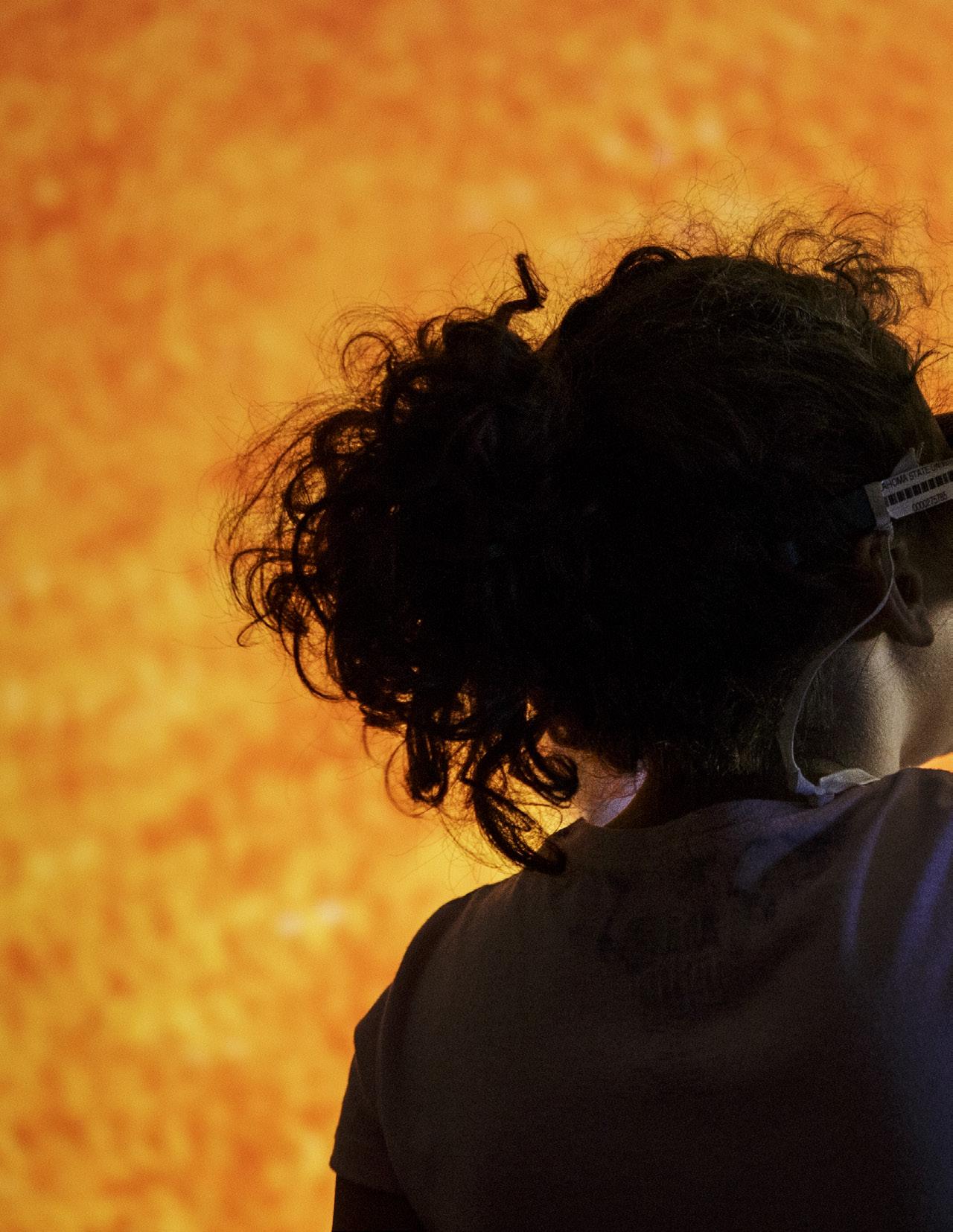
World The LearningTomorrow of
4 Research at Oklahoma State University • www.research.okstate.edu
PHOTO / GARY LAWSON
With funding from the Office of the Provost at OSU, the research team is collaborating with Mary Sweet-Darter of the University of Central Oklahoma. As a member of the Oklahoma Autism Task Force, Sweet-Darter has been instrumental in creating a network of services for families with children diagnosed with an autism spectrum disorder.
Damon Chandler, associate professor in the School of Electrical and Computer Engineering, and Mwarumba Mwavita of OSU’s College of Education have been
working closely with Cecil on this groundbreaking research.
“A graphics-intensive virtual communication medium has the potential to engage and encourage children to learn through exploration,” says Chandler. “Once a child is immersed in a virtual reality environment, very few of them want to leave it and do something else.”
VLE-based techniques have been used successfully for the general population at both the K-12 level and at the undergraduate and graduate levels in engineering courses, Cecil says. In fact, OSU’s College of Engineering, Architecture and Technology is pioneering an innovative approach where students can learn by immersing themselves in 3-D learning environments.
Although the study is still in early stages, this OSU research group hopes its findings can be used in developing school curriculum and community opportunities that stimulate children with these needs.
Cecil says his research group is continuing to look for additional partners. His group plans to create an Oklahoma Educational Initiative with more emphasis on helping those with autism learn science and math.
“This research is just the beginning in helping shed light on this area,” says Cecil. “Our group is interdisciplinary in its outlook and this enables us to provide a unique perspective on both technology and learning.”
Chandler indicates that the group’s findings will not only
“Once a child is immersed in a virtual reality environment, very few of them want to leave it and do something else.”
— Damon Chandler
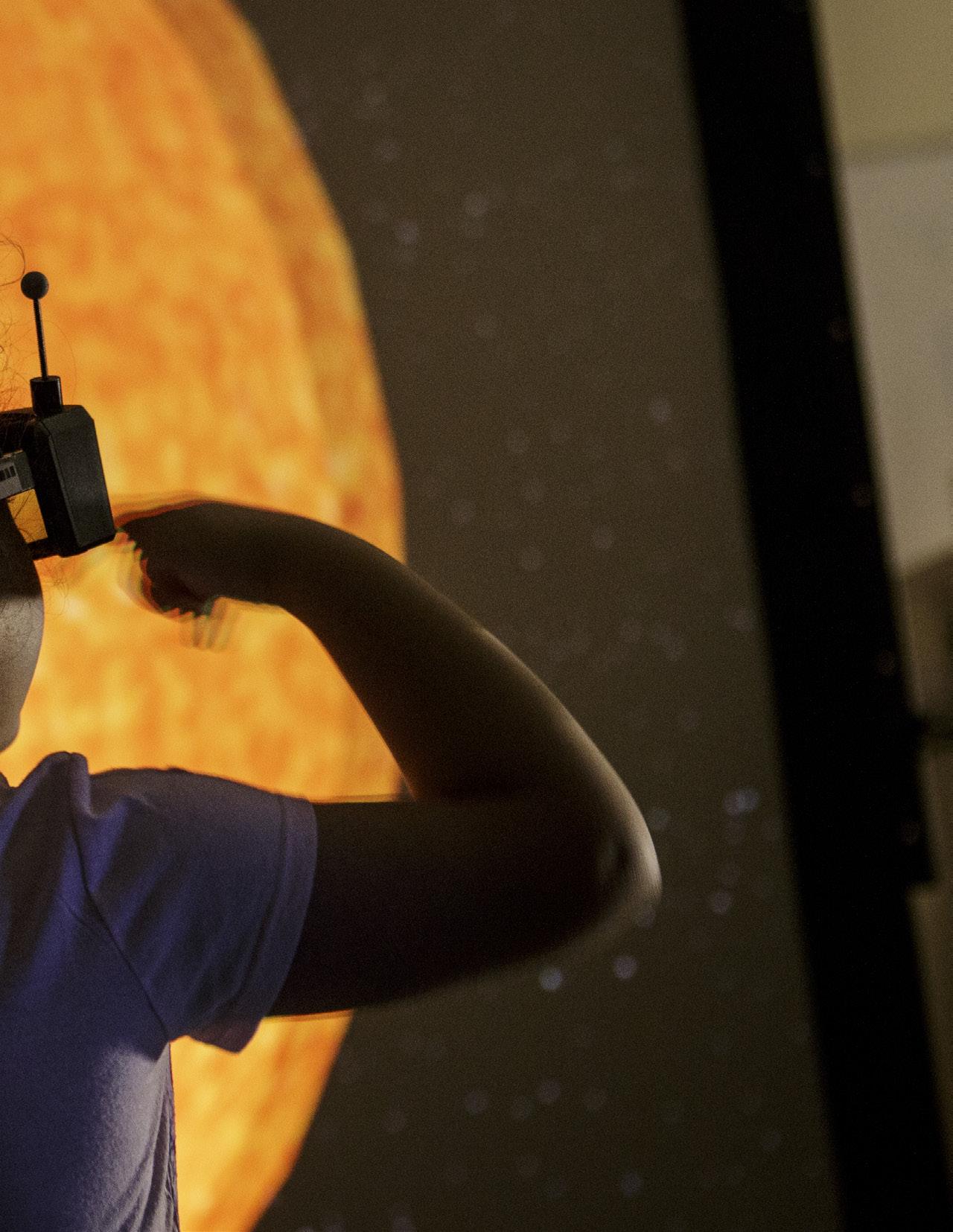
“We chose to study this area of research because we wanted our engineering research to have a more direct impact on helping children learn,” says Cecil. “The longterm outcome will hopefully be to enable those with autism to function at high levels independently.”
“In this pilot project, we will design virtual environments for autistic children and study its impact on their learning of basic science and math concepts,” says Cecil. “We will be working with around 20 children under the age of 10, one-on-one for a few years to generate the data we need to establish results.”
affect children with autism, but they could also help identify new ways to encourage science and engineering learning in K-12 and higher education.
Cecil says designing new educational technologies is vital to keeping all children interested in science and engineering, as well as opening doors to students who might otherwise not consider careers in science, technology, engineering and mathematics.
The research takes place through the Center for Information Centric Engineering. For more information on research at CICE, visit www.okstate.edu/cinbm.
WRAVE nn A BlOOMBERG
5 Research at Oklahoma State University • www.research.okstate.edu
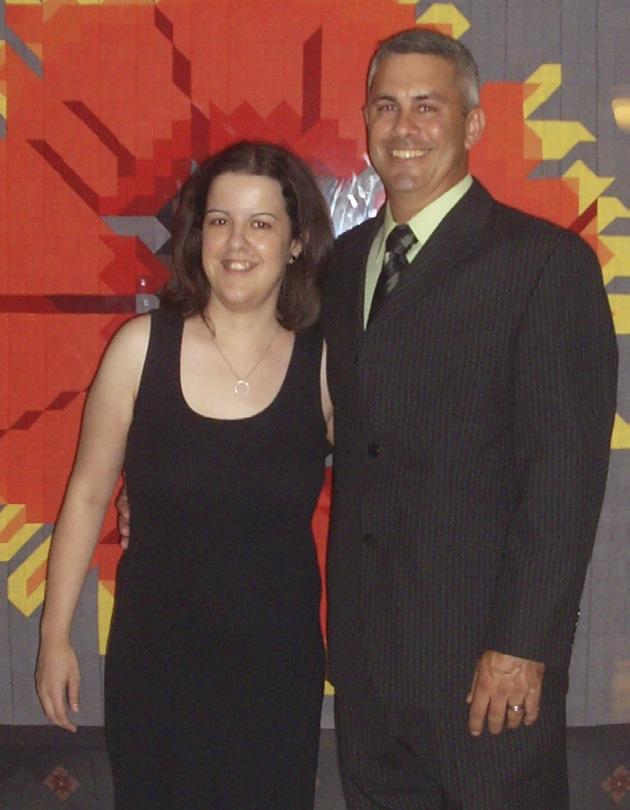
Mandy Darr, at left with her cousin, and Nikki Smith, below with her husband and three sons, recognize the importance of family. Both are sufferers of Polycystic Kidney Disease, a common lifethreatening genetic disease that currently has no cure. Both stand to benefit from research led by Dr. Myron Hinsdale at the Oklahoma State University Center for Veterinary Health Sciences.
POWER The
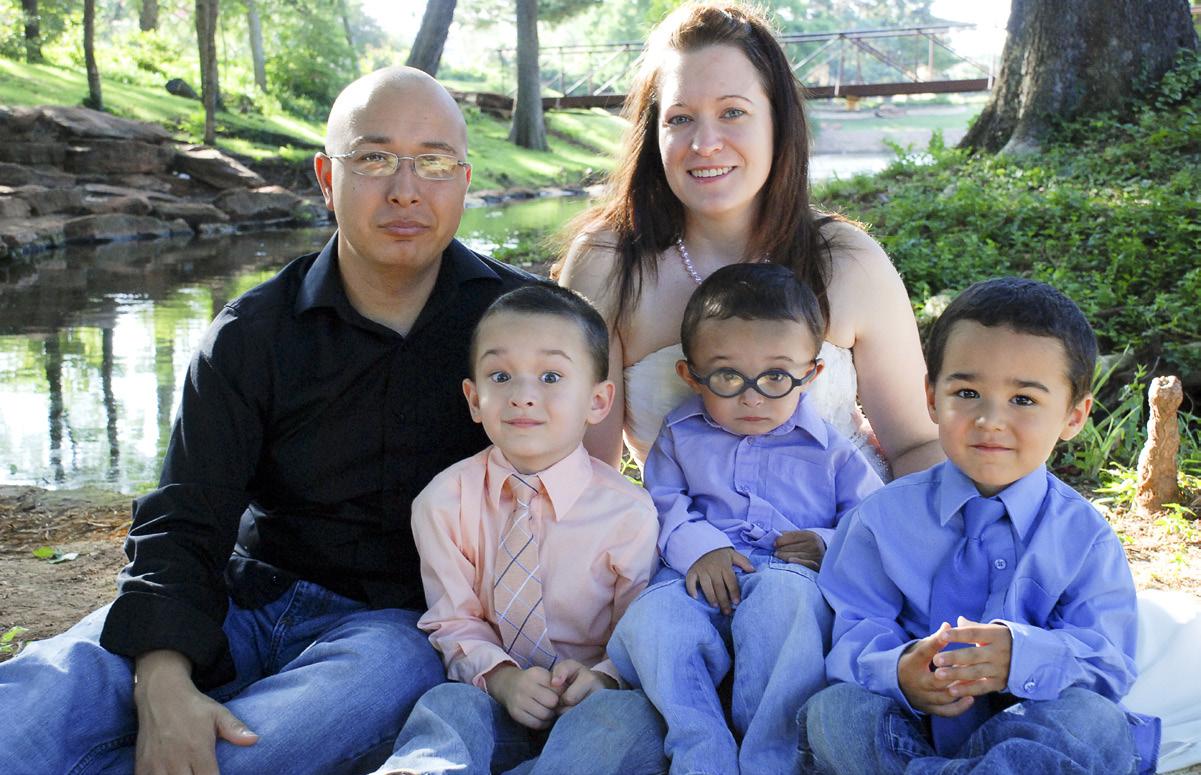
6 Research at Oklahoma State University • www.research.okstate.edu
PHOTOS PROVIDED
Thirty-year-old Mandy Darr received a kidney transplant last year.
“After I was born it was discovered I had gotten Polycystic Kidney Disease (PKD) from my mom,” Darr said.
Her kidneys were three times the size they should have been and doctors thought she was not going to make it. Her family was told she would need a transplant by the time she was a teenager.
However, Darr’s sister has not had any adverse effects from the disease.
Nikki Smith has also has a family history of PKD. She lost her father when he was 44 and her grandfather when he was in his 30s.
“I am 28 years old and have known since I was 16 that I have PKD,” Smith said. “Two out of three of my little boys also have PKD.”
POWER of a PROTEIN
“I did not slip into renal failure until I was around 24 or 25,” Darr said. “When I got all of my tests done, I was on the list for about a year and a half.”
Darr’s donor was her dad’s best friend who originally offered his kidney to her mother. Mandy Darr has a long family history of PKD and her younger sister (and only sibling) has it as well.
Smith’s only brother and her aunt also have PKD.
PKD is one of the most common life-threatening genetic diseases, affecting an estimated 12.5 million people worldwide. PKD is more common than cystic fibrosis and multiple sclerosis. One in 500 to one in 1,000 people are affected by PKD. STO
NUES
7 Research at Oklahoma State University • www.research.okstate.edu
ry CONT i
>

“PKD affects people at any age,” said Dr. Myron Hinsdale, an assistant professor in the Department of Physiological Sciences at the Oklahoma State University Center for Veterinary Health Sciences. “You never know who might have the disease. It can start during the prenatal stages of development or it will occur during old age.”
The genetic disorder results in cystic development in multiple organs
but always affects the kidneys. There are two types of PKD: autosomal dominant polycystic kidney disease and the less common autosomal recessive polycystic kidney disease. It arises from mutations in three different genes. Both humans and animals can be affected.
There is a wide range of severity and disease progression, suggesting that other genes within a person’s DNA can modify the course of the disease. For example, even members of the same family who share the same mutation(s) can differ in disease severity. The fluid-filled cysts are numerous and compress and damage
normal tissue in the kidneys. The disease can also damage the liver, pancreas and, in rare cases, the heart and brain.
The focus for Hinsdale’s research is on proteins located at the cell interface or the area around the cells, called the extracellular matrix. He believes these proteins are important modifiers of the disease severity. At OSU, he studies how cells behave with respect to injury or aging and he collaborates with the Nephrology Department at the University of Oklahoma Health Sciences Center in Oklahoma City and investigators at the Oklahoma Medical Research Foundation.
8 Research at Oklahoma State University • www.research.okstate.edu
Dr. Myron Hinsdale (center) currently has five members on his research team. They are (from left) graduate student Nabin Poudel, DVM; research technician Huan Song, master’s in molecular and cellular biology; research associate Maria Cristina Munteanu, Ph.D. in biology; graduate student Girija Regme, DVM; and postdoctoral fellow Sivasami Pulavendran, Ph.D. in cell biology.

Animal models are indispensable to the study of PKD. The most common way to study a disease like PKD in animal models is to use embryonic stem cells. Embryonic stem cells are derived from the inner cell mass of the blastocyst, an early-stage embryo. Pluripotent stem cells are often termed “true” stem cells because they have the potential to differentiate into almost any cell in the body. This means that under the right circumstances, a stem cell that is isolated from an embryo can produce any cell in the body.
For the research being conducted, the researcher takes mouse embryonic stem cells that contain the mutation they are interested in and inject them into early mouse embryos called blastocysts. These are then implanted into a female mouse, who gives birth to the mutant mice that are bred for study. Dr. Oliver Smithies, with whom Hinsdale studied, received the Nobel Prize in Physiology or Medicine in 2007 for discoveries in this technology. Hinsdale used this technique to generate mice mutant in proteoglycans.
Using the recently generated knockout mouse model of proteoglycan biosynthesis, Hinsdale’s laboratory is revealing important roles of extracellular matrix proteoglycans on epithelial cell homeostasis. One important novel finding in these mice is that decreased extracellular matrix proteoglycans cause organ fibrosis and cyst development in the liver and tubule dilation in the kidney that is a possible pre-cystic lesion. These are all defects seen in PKD patients.
“We are using the mice to help us understand why patients get sick, at what age, how fast they get really sick, whether they require dialysis or a kidney transplant, and how the extracellular matrix around the cells affects that,” Hinsdale said.
This is important since 70 percent of patients with PKD have considerable morbidity due to organ fibrosis and liver cysts. Therefore, their results predict that proteoglycans may be important genetic modifiers of cyst development.
Since fibrosis of the liver and kidney and alterations in extracellular matrix proteoglycans are often found to develop together in multiple disease syndromes, their results may be important and applicable to the treatment of many kidney and liver diseases. The long-term goal of Hinsdale’s research group is to identify the cellular mechanisms responsible for these changes.
“I think it is good they are doing research on PKD,” Darr said. “I used to travel to Colorado with my mom and younger sister to let them run tests on me at the University of Colorado. The first visit I made up there was at the age of 4 with my mom.”
The PKD Foundation is committed to discovering treatments and a cure for Polycystic Kidney Disease. Its mission is to promote research, advocacy, education, support and awareness to discover treatments and a cure for PKD and improve the lives of all it affects. The vision of the PKD Foundation is that one day no one will suffer the full effects of PKD. The website (www.pkdcure.org) has more information on the genetic disease along with testimonials from people affected. The website also has many different ways for people to contribute to the foundation through donations and advocacy.
Having attended both national and local PKD foundation meetings, Hinsdale has had a chance to meet people like Darr and Smith who are affected by this disease.
“It is an eye opener to see that people really do exist who are affected by this debilitating disease. It puts a face on the disease that is unforgettable,” Hinsdale said.
Even though work takes up a large portion of his time, Hinsdale still enjoys finding the time for leisure activities like fishing and biking.
“I can never stop thinking about my research and work,” Hinsdale said. “It can become stressful at times and very difficult for my family, but I try to do my best for them.”
He says they are very understanding and supportive.
“I would rather run than bike, but I am just getting too old,” Hinsdale said jokingly.
Now after her transplant, he and Mandy Darr have that in common. She takes part in the Oklahoma Walk for a Cure to try to raise money for the cause.
PAIGE VA n DAVEER
9 Research at Oklahoma State University • www.research.okstate.edu
PHOTO / GARY LAWSON
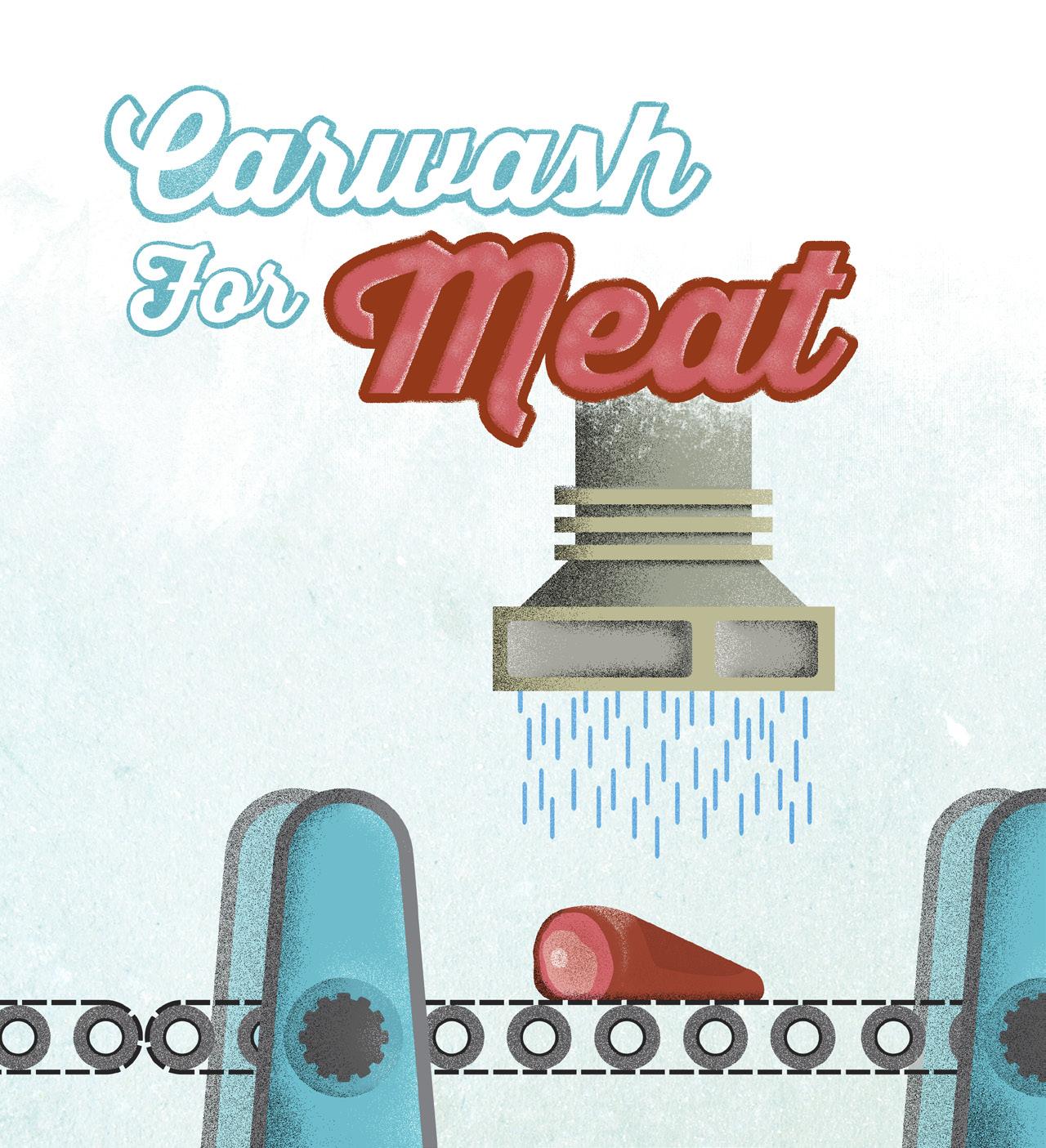
FAPC shifts into high gear and partners with a national company to benefit Oklahoma’s food industry
10 Research at Oklahoma State University • www.research.okstate.edu
You ride on an automated conveyor belt rolling through a darkened tunnel, passing several pieces of equipment, each with a specific purpose — rinse, soap, foam and dry. You exit squeaky clean and free of flaws.
What if this same concept was applied to meat products to eliminate the possible bacteria that could harm consumers and devastate a meat manufacturer?
Oklahoma State University’s Robert M. Kerr Food & Agricultural Products Center is doing just that — researching what some are calling a “carwash for meat.”
Preparing to enter
The FAPC is collaborating with Ross Industries Inc. of Midland, Va., to study using antimicrobial spray treatments on blade-tenderized meat.
“Many companies in the meat industry use mechanical tenderization to render cuts of beef more tender than they currently are,” said Peter Muriana, FAPC food microbiologist.
One mechanical tenderization process is blade tenderization, in which a group of blades pierce a cut of meat. While the process improves tenderness, it also can create an opportunity for bacteria to potentially enter the meat.
“The United States Department of Agriculture’s Food Safety and Inspection Service has recently taken issue with mechanically tenderized beef as non-intact beef,” Muriana said. “The concern is that pathogenic E. coli 0157:H7 or other Shiga-toxin producing E. coli serotypes, may be on the surface of the meat and could be
translocated into the interior of what may appear as solid beef cuts, such as tenderized steaks. It could manifest itself as a health hazard if someone were to consume a tenderized steak that was cooked rare or medium rare.”
Rolling through the process
To tackle this issue and reduce the risk of bacteria, the FAPC teamed up with Ross Industries, one of the largest manufacturers of meat tenderizers, food packaging equipment and food processing systems, to research the application of antimicrobial sprays to treat meat.

“It’s kind of like a brushless car wash for meat,” Muriana said, to put the concept in laymen’s terms.
The meat is loaded in the front end of the machine and is pulled through an antimicrobial spray system. Then, the meat continues on and reaches the blades used for tenderization.
“We wanted to prove that a blade tenderizer with a contamination intervention integrated into it would reduce microbial contamination risks and prevent recalls,” said Wayne Spillner, Ross’ manager of processing equipment development. “We wanted to conduct research at an academic facility to ensure confidence in the research.”
The initial project included using 14 different antimicrobials from 10 different suppliers, all approved for use on meat by the FDA and USDA.
“We examined the antimicrobials for effectiveness against E. coli 0157:H7 on inoculated lean beef discs passing through the Ross spray system, as well as the effectiveness of antimicrobials on beef sub-primals in combination with blade tenderization,” Muriana said.
A Clean Exit
According to Muriana, the initial results revealed that those antimicrobials showing the best microbial reduction demonstrated the least microbial translocation during beef tenderization.
story continues >
11 Research at Oklahoma State University • www.research.okstate.edu
“We proved that if you have an effective intervention product, you minimize the risk of dragging potential pathogenic bacteria from the surface of a steak or roast into the center of the meat,” Spillner said.
Ross has implemented spray systems on the front end of its commercial blade tenderizers since the study’s completion.
“Our information shows over 50 percent of the meat in the marketplace has been tenderized to improve its palatability,” Spillner said. “If we can enhance the safety of non-intact meat, meat will continue to be reasonably priced, safe and enjoyable for the consumer.”
According to Spillner, the research was accepted by the USDA and has been mentioned in articles, which has led to more interest in the research.
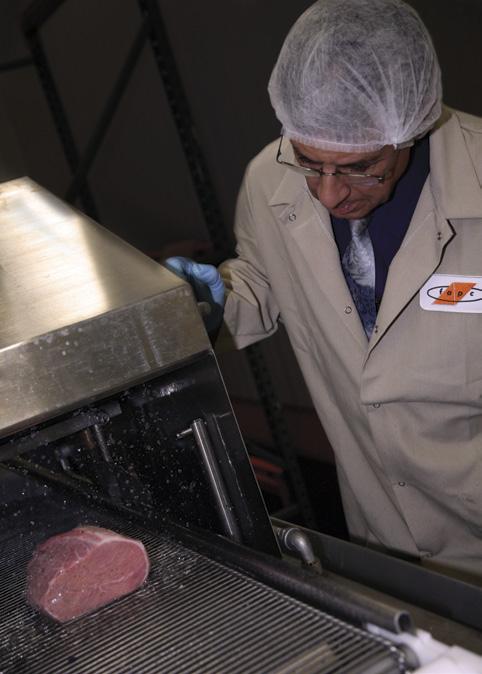
“Having the availability of an academic outlet in research is beneficial when a customer comes to us and asks, ‘How can I do a validation study?’ … We have somewhere to send them,” Spillner said. “It’s been a good collaborative partnership that brings additional customers to OSU, as well as to Ross Industries, but a real winner is the processing industry when they use this information to get impactful results once we have them summarized and published.”
This information is useful to meat equipment companies, processors and antimicrobial suppliers.
“Antimicrobial suppliers are using our data to help educate customers, and Ross Industries has sold more machines,” Muriana said. “The safer their customers manufacture products, the more capable they are of selling products with low safety risks.”
John Williams, president of Chef’s Requested Foods of Oklahoma City, supports this research and stresses how food safety is a critical priority for food manufacturers.

“You can address a product’s flavor, quality, how it eats and appears on the plate, but before anything else, the product must be assured to be 100 percent wholesome and safe to consume,” Williams said. “This research plays a huge role in addressing this issue.”
This research helped Chef’s Requested revise the composition of its meat marinades. Based on this research, and previous work done by Muriana, Chef’s Requested was able to utilize one of the antimicrobials that allowed an enhancement in flavor, plus increasing the shelf life of its refrigerated beef products.
Down the road ahead
Sherry Nichols, the wife of a beef producer in Arnett, Okla., and an avid beef consumer herself, said she believes the food safety research being conducted at the FAPC benefits consumers as well as beef producers and manufacturers.
“I believe the United States has the safest food supply in the world,” Nichols said. “However, with that being said, I believe the food industry is constantly working to make sure that food is continuously safe for consumers.”
This kind of research is what limits the amount of outbreaks caused by foodborne illnesses.
“Consumers’ health and the livelihoods of food manufacturers are on the line if there are outbreaks or food recalls,” Nichols said. “Any kind of food safety research is considered insurance for the food manufacturers’ livelihoods and the health of consumers.”
Williams called this research relevant to any consumer who purchases meat products.
“This research benefits consumers in that they can continue to enjoy a beef steak or roast at a cooked temperature that they love, rare to well done, with the assurance that it is safe,” Williams said.
Although they have achieved these results, the FAPC and Ross Industries will continue to carry on research regarding blade tenderization.
“We will continue to research with Ross Industries to find additional and better solutions,” Muriana said.
The discovery made by this research will lead to continuous research development to ensure safe and wholesome products for consumers.
“The more intervention effectiveness we can apply to fruits and vegetables, as well as meat and poultry products, means less risk to the public,” Spillner said. “If we can add additional safety hurdles with minimum efforts or cost, the food supply chain is going to be safer, and America is going to be healthier.”
R EBECCA B AI lE y
Peter Muriana, a food microbiologist at OSU’s robert M. Kerr Food & Agricultural Products Center, watches as an antimicrobial spray is applied to a cut of blade-tenderized meat. The FAPC has partnered with industry to evaluate the spray’s ability to prevent the spread of harmful bacteria.
12 Research at Oklahoma State University • www.research.okstate.edu
PHOTO / REBECCA BAILEY
Power The ofPR

professor views public relations through a different lens
OSU
PHOTO
/ PHIL SHOCKLEY
STO ry BEG i NS >> 13 Research at Oklahoma State University • www.research.okstate.edu
Derina Holtzhausen
OSU professor Derina R. Holtzhausen knows the field of public relations is often seen as frivolous.
And why not? People in the profession polish the public’s perception of fat-cat corporate executives (think of Enron’s Kenneth Lay), rehab the images of hardpartying celebrities (Charlie Sheen) and spin the truth for politicians everywhere (pick one).
“The political transition in South Africa led me to critiquing how powerful organizations and people use public relations to promote their own agenda and to strengthen their own power,” she says. “That critique led me to learning how power in Western society works, which eventually led me to a postmodern approach.”
Today, Holtzhausen is one of the foremost experts on postmodern public relations, a fairly new


But Holtzhausen, director of the Oklahoma State University School of Media and Strategic Communications, argues that PR is a meaningful profession. As a native Afrikaner, she saw the role it played during apartheid in South Africa.
research field in academia. International business communications expert David McKie, a professor at the University of Waikato in New Zealand, calls Holtzhausen the major writer on postmodern public relations internationally.
“Dr. Holtzhausen has established a solid body of work in top journals and produced the first fulllength book study on the field, which is highly rated around the world,” he says. Rebuilding a country Holtzhausen didn’t start out in PR — or even studying it. In 1971, she earned bachelor’s degrees in Afrikaans Dutch Literature, German and psychology from the University of Pretoria, one of the largest universities in South Africa.
She followed a creative path after graduation, helping specialneeds teens, working as a journalist and managing PR for a small ad firm.
In 1976, she and her husband, Paul, opened Holtzhausen Publicity and Advertising in Johannesburg, handling accounts for banks, insurance companies and savings and loans.
Holtzhausen also honed her PR skills and continued her education, earning a master’s in Afrikaans literature in 1990 and a doctorate in communication science in 1995.
In 1992, she was hired as head of corporate communications for the South African Tourism Board, one year after apartheid ended. Holtzhausen’s job was to help rebuild South Africa’s global image.
“PR practitioners became the bridge-
builders between grassroots movements and the powerful organizations they worked for,” she says. “I had a critical role during this transition. This role shaped my interest in postmodern PR as a form of activism.”
Starting over
While in South Africa, she had met University of Maryland Professors James and Larissa Grunig, a husband-and-wife team of world-renowned public relations academics.
During her doctoral research, Holtzhausen received a $5,000 grant from the South African Human Sciences Research Council and traveled to College Park, Md.
The two were impressed with Holzhausen’s work, encouraging her to teach in the U.S. “They saw something in me and it opened the way for my career,” she says.
The pair kept her apprised about job openings, which led to Holtzhausen’s finding a faculty opening at the University of South Florida’s School of Mass Communications.
In 1997, Holtzhausen accepted a job as an assistant professor at USF in Tampa. The timing was perfect for her family’s move to the U.S. Her husband, Paul, found a magazine job in Florida, and their son, who had just graduated high school, was preparing to study film-making in America.
PHOTO PROVIDED
14 Research at Oklahoma State University • www.research.okstate.edu
Holtzhausen celebrates the 100th anniversary of the Association for Education in Journalism and Mass Communication with students and faculty from the School of Media and Strategic Communications.
“I completely started my career over when I moved to the U.S.,” she says.
Starting over wasn’t easy — part of her new venture meant publishing scholarly articles. Not being familiar with the journal academic process in the U.S. hampered her efforts, she says.
“It took three years to get my first article accepted,” she says. “I was shot down in flames each time I submitted an article.”
Since that start, Holtzhausen has published 27 scholarly articles and book chapters, presented her findings at more than 45 conferences and received more than 20 grants and awards. She has mentored more than 35 graduate students in her career, several of whom have become professors at the University of Miami, University of Maryland and Georgia State University, among other schools.
In 2008, an OSU search committee approached Holtzhausen and asked her to apply for director of the OSU School of Journalism and Broadcasting. Her research had come to committee members’ attention through the Association for Education in Journalism and Mass Communication, the most influential organization in journalism and mass communication education in the U.S.
Holtzhausen did so, won the position and for the next few years worked to rebuild a school whose mission was rapidly changing.
“There were hints of the school’s name being changed when I started, so as school head, the first order of business was to review the curriculum,” she says. What she discovered was the school needed a name that would more accurately describe its mission.
In 2010 — in the face of some resistance from alumni and professors — the school changed its name to the OSU School of Media and Strategic Communications. Bachelor’s degrees now are offered in strategic communication, multimedia journalism and sports media.
“The curriculum changes better prepare students for successful careers in today’s rapidly evolving media landscape,” she says.
Making sense of language
Along with her administrative duties, Holtzhausen keeps up with that rapidly changing media landscape through the research she started at Rand Afrikaans University (now University of Johannesburg) in Johannesburg in 1995.
She has taken her research and published it in a book titled Public Relations as Activism: Postmodern Approaches to Theory & Practice
Holtzhausen uses vignettes to explain her studies.
The 2007 Don Imus saga is a perfect example of the power of language, she says. Imus, a popular radio host, referred to the members of Rutgers University’s female basketball team as “nappyheaded hos” and “rough girls from Rutgers” because they had tattoos.
“This is a cautionary tale to PR practitioners on how the language we use can shape stereotypes and belief systems,” Holtzhausen says. “It also shows how power functions in our society and how PR professionals can become enamored with powerful media personalities without thinking of the ethical consequences.
“Imus was a regular outlet for PR professionals to promote books and powerful careers. They were well aware of his views but used him nonetheless.”
Another example she uses is that of Emily
Hobhouse, a British welfare campaigner who worked to change the conditions inside the British concentration camps in South Africa built for Boer women and children during the Second Boer War.
Hobhouse formed a relief fund that got little attention from the British. So instead, using the power of language and her privileged upbringing, she wrote about the atrocities of war in a book that is said to have ended the war.
“Hobhouse is another example of how those with power used their PR skills to change the mindset in Britain about the war,” Holtzhausen says.
Holtzhausen’s research is loaded with other examples of how PR can be used in negative and positive ways.
All the examples have one goal.
“The major focus of postmodern is the critique of power — a focus on ethics,” she says. “Language is not benign. Language is not neutral. Our language in PR is important. We contribute to the perceptions of others.”
lORE
n E A. R OBERSO n
Want to see more about Derina Holtzhausen and her work?
you can watch a video by scanning the code on the right or byvisiting journalism.okstate.edu/ index.php/faculty/ 69-derina-holtzhausen

15 Research at Oklahoma State University • www.research.okstate.edu
A Model for Student Growth
Aresearch model designed by Mwarumba Mwavita is making a significant positive impact on one Oklahoma school district and gaining notice across the state and nation.
Mwavita, who teaches in the Research, Evaluation, Measurement and Statistics (REMS) program in the College of Education’s School of Educational Studies, developed a comprehensive model for mapping student achievement growth. His unique bigpicture approach tracks student growth in a single school year and considers a variety of factors that can influence student achievement.
Mwavita has worked closely with administrators, teachers and students in the Western Heights School District in southwest Oklahoma City over the last four years, implementing the model and analyzing the data to better understand challenges and find solutions that are effective.
“Most studies have been working only on mapping students’ growth from year to year, (comparing) different
students,” Mwavita says. “For instance, a third-grade student in one school year is compared to third-grade students in the next class. The same students are not tracked over time.”
As part of Mwavita’s model, students are pre-tested at the beginning of a school year, given a second test in the winter and finally a last test in the spring. The test is standardized, computerized and adaptive to individual ability. It has been aligned with Oklahoma’s Priority Academic Student Skills (PASS) but can easily transition to the state’s new Common Core Standards. The test is also diagnostic, revealing if a group of students does not understand a concept.
“It helps inform instruction, indicating what teachers should focus on,” Mwavita says.
“This assessment model is data-based, but goes well beyond the normal testing program,” says OSU Regents Professor Dale Fuqua, who also teaches in the REMS program. “It provides timely feedback to both students and teachers.”
The immediate feedback motivates students, helping them track progress and set goals. It is also valuable for parents.
“Parents are well-served by having immediate results several times a year to inform their participation in decisionmaking and use of interventions with students,” Fuqua says.
In the sophisticated system, all of the data gathered is recorded and accessible electronically by teachers and administrators. It has led to a culture where Western Heights depends on data for decision-making, and it has proved powerful for teachers.
More and more, discussion about education centers on evaluating teachers for effectiveness. Mwavita has seen strong buy-in from Western Heights’ teachers and students.
“We’re big believers in adaptive testing,” Western Heights school superintdent Joe Kitchens says. “We absolutely believe that it’s critical to know who students are when determining whether a teacher is successful or not.”

Teachers have instant access and
“There is passion for making a difference in the schools in the state. Our job is to be resourceful to all stakeholders. How can we best serve the citizens of Oklahoma and be efficient in making a difference in our schools?”
– Mwarumba Mwavita
16 Research at Oklahoma State University • www.research.okstate.edu

receive training on how to read the data, allowing them to respond by immediately designing instruction to meet students’ needs.
“A teacher has these students for one year,” Mwavita says. “Within that one year, you can evaluate a teacher’s effectiveness (with) that test after controlling for other variables such as initial ability, parental involvement, whether they are in special education classes or have free and reduced lunch status. If you put all of them into the model and what will remain is not explained by all of these other variables, we can use that residual effect to predict the teaching impact.”
Western Heights had battled mobility, with students moving in and out of the district. This drove the decision to test students at the beginning of the year on all the content they will be covering. It helps teachers know where their students initially stand academically.
“Dr. Mwavita has been so critical in helping us understand how to look at this data in a proactive way to use it in a proactive way,” Kitchens explains.
Another element of this model is the creation of and support for Professional
Learning Communities (PLC). The PLCs meet outside the normal school day, giving teachers the opportunity to share information, learn more about their students and identify better ways to meet their needs in the classrooms and beyond. Teachers are compensated for their time and work.
“(Mwavita) has a great way with teachers,” Kitchens says. “His ability to interact with them in regard to what they see and what action they may take, I think may be the most important thing of all. He has a unique capacity to put people at ease and to have an open discussion about what the real issues are and what can be done on behalf of students.”
Mwavita came to Oklahoma State University from Kenya to pursue a doctorate in educational psychology, specializing in REMS. After completing the doctoral in 2005, he accepted a visiting assistant professor position at OSU. He has also served as Western Heights’ director of school improvement and instructional research and continues to support the district while working at OSU. His research focuses on
mapping student achievement growth and improving student performance and teacher education.
Mwavita’s work has garnered national notice. He communicates regularly with the U.S. Department of Education’s National Center for Education Statistics and has been asked to present at professional development workshops, showcasing his work with Western Heights in terms of growth modeling and changing the culture of the school.
“It is not one size fits all, but the principles of the model will work across school districts,” Mwavita says. “Each school may have its own unique challenges, and the model will take that into account.” For example, a district with many highachieving students can use the model to help determine how best to challenge, accelerate and motivate learning.
“A beauty of the model is that you can see it is more accurate and fair for teachers,” Mwavita says. “You can see growth even if (students) aren’t achieving at the average. Teachers are not ‘graded’ in the same way for students who only spend two months of the year in their classes. It truly looks at the impact the teacher has on the student in the time they teach them.”
The work is a strong example of the university’s land-grant mission being carried out. Currently, Mwavita and his colleagues at OSU are in continuing contact with other school districts in the state as well as with the State Department of Education.
“There is passion for making a difference in (the schools) in the state. Our job is to be resourceful to all stakeholders,” Mwavita says. “How can we best serve the citizens of Oklahoma and be efficient in making a difference in our schools?”
That’s the question that guides the work.
C HRIS ty lA n G
Mwarumba Mwavita from the College of Education’s School of Educational Studies has developed a comprehensive model for mapping student achievement growth, and it’s making an impact in one Oklahoma school district.
17 Research at Oklahoma State University • www.research.okstate.edu
PHOTO / GARY LAWSON
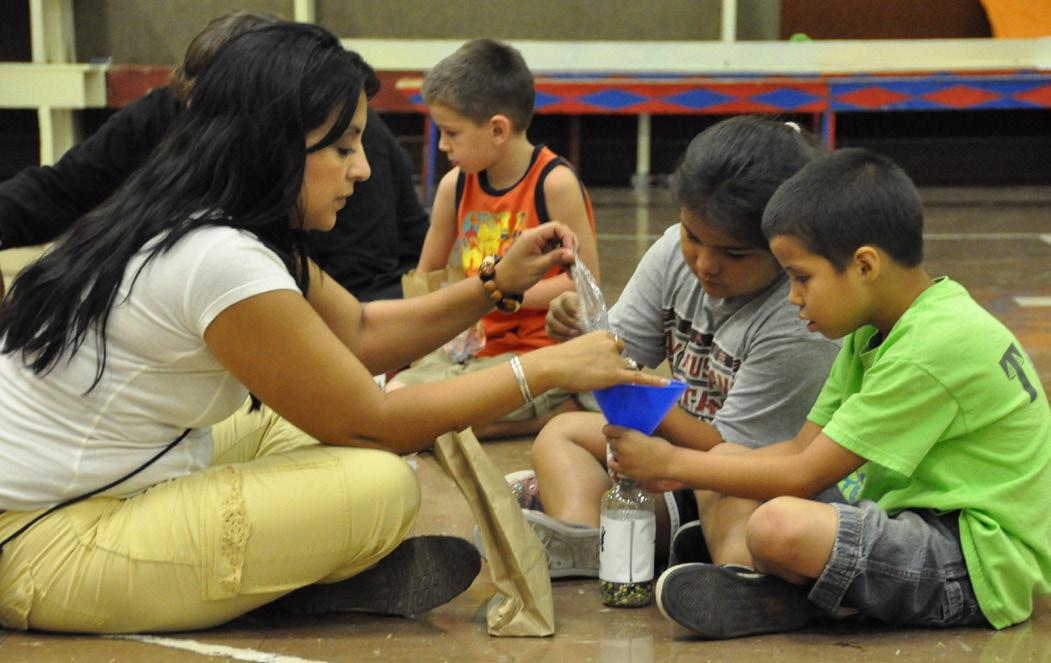
Human Sciences Research focuses on Native American Health and Well-being
According to the 2010 U.S. Census, Oklahoma has the second-largest number of American Indians in the country. Professors in Oklahoma State University’s College of Human Sciences are steering a range of research projects to improve the physical and developmental health of this significant portion of the state’s population.
Several of those studies concern Type 2 diabetes. On average, American Indian and Alaska Native adults are 2.6 times more likely to have diabetes than non-Hispanic whites of similar ages are, according to the Centers for Disease Control and Prevention.
Nutritional sciences professor Brenda Smith and University of Oklahoma Health Science Center researchers began a study in 2007 of 300 Native American women over the age of 50 to understand the connection among diabetes, inflammation and osteoporosis. She says estimates are that by 2020, half of all women over 50 will suffer at least one bone fracture — and 25 percent of men will, too. For people with diabetes, the chances of a bone fracture are twice as high.
Since Native American women are largely underrepresented in osteoporosis studies, interest from tribes, clinicians and participants was high. Smith says, “Excitement for the study spread by word of mouth so efficiently that recruitment for participants was made easier than usual.”
The team looked at bone mineral density, bone metabolism and inflammation’s role. Calcium and vitamin D levels and other nutritional variables were measured. The study also looked at exercise, particularly what the study participants did as teens and young adults when peak bone mass was accumulating.
“Based on data we have,” Smith says, “we anticipate at one point being able to determine the relationship between diabetes and osteoporosis.”
The participants returned for two follow-up visits, a year apart, to have their bones rechecked. Many reported they were making positive changes for their health and expressed a desire to pass on better health to the next generation, an attitude Smith calls “heart-warming.”

Another nutritional sciences professor, Stephany Parker, is interested in Type 2 diabetes prevention. Since 2006, Parker and her team have been working with Sarah Miracle, the Chickasaw Nation Get Fresh! program manager, and others to create a participant-oriented social marketing program to help prevent the disease in Native American families.
“One after another, mothers talked about parents or grandparents who had suffered from the disease,” Parker says. “And they expressed concern for their children.”
That concern is not without cause. The CDC and Prevention Office of Minority Health Disparities reports that Native Americans ages 10-19 have the highest prevalence of Type 2 diabetes among people younger than 20.
To that end, Parker and her team devised the Eagle Adventure program, which is implemented in schools with a high proportion of Native American students and incorporates regional Indian languages and tribal activities.
18 Research at Oklahoma State University • www.research.okstate.edu
During the Eagle Adventure, grant coordinator Sara Mata helps students make shakers for the snake dance, a traditional form of physical activity. PHOTOS
PROVIDED

Revitalizing tradition was important as well, so Parker came up with the idea of a play based on the CDC’s Eagle books to bring the Native American tradition of storytelling to the program.
“Not only does the play bring the story to life, but when children are watching the characters Rain that Dances and Thundercloud, they have role models,” Parker says. “They see the characters learn to choose foods from the garden and be more physically active, and they learn.”
Each play is followed by four in-class lessons where children talk about their own health and nutrition habits, learn Native American words, try new ingredients and receive recipes, activities and games to take home. More than 2,000 Oklahoma students in grades 1-3 have participated in the Eagle Adventure program since its February 2010 launch.
In 2012 the Eagle Adventure Program won the Dr. Rodney Huey Memorial Champion of Oklahoma Health award for its unique and effective approach to improve Oklahoma health. Recent results indi-
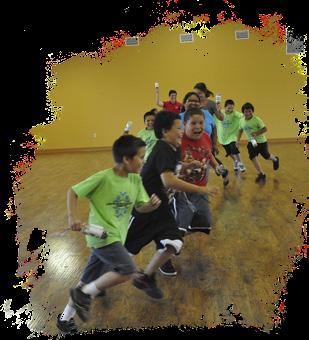
Education, Hubbs-Tait suggested curriculum adap tations for each child’s specific academic areas needing strengthening, based on test scores each fall. Several tools were used to help more than 45 percent of the preschool children meet age-appropriate levels of verbal reasoning, pictorial memory and perceptual reasoning.
“The individualized, home- and classroom-instruction curricula helped, as did dedicated staff and parents, culturally relevant materials and lessons, two teachers per class, and a national board-certified Frog Street curriculum,” she says.
Frog Street is a bilingual/bicultural curriculum that integrates English and Spanish, but the Oklahoma teachers substituted the Pawnee language and culture for the Spanish components of the program. In addition, Warren Pratt Jr., an adjunct American Indian studies instructor at Pawnee Nation College, taught the Pawnee language
“One after another, mothers talked about parents or grandparents who had suffered from the disease (Type 2 diabetes). And they expressed concern for their children.”
— Stephany Parker
cate that more than 78 percent of children in the program wanted to eat more vegetables, and nearly 70 percent said they were doing the “Eagle Moving” activities with their parents.
Working with the Pawnee Nation’s Pa<ee Pakoo<oo (pronounced padee pakoodo) Early Learning Center, which serves 3- and 4-year-old children and their families, Human Development and Family Science Regents Professor Laura Hubbs-Tait has also been helping Oklahoma’s Native American children.
An external evaluator for the fiveyear project funded by the U.S. Department of Education Office of Indian

to the teachers each summer, who in turn taught it to the children.
“We found the academic progress that we expected,” Hubbs-Tait says. “However, without the increase in emotional development and behavioral self-control, we do not believe that we would have seen the growth in cognitive and language milestones.”
Another professor interested in lifestage adaptation is Tammy Henderson, who is researching the roles, needs and challenges of Alaska Native grandparents, a population rarely examined.
Funded with $1.15 million from the National Science Foundation,
Henderson is learning how technology, a mixed cash and subsistence economy and popular culture from the Western states are altering life for Alaska Natives. With more grandparents serving as primary caretakers for grandchildren, fiscal challenges are on the rise. Social and legal services are sometimes needed. By studying a diverse group of grandparents, for whom tradition, family and community are such core values, the hope is that more will be known about grandparents everywhere.
“Sometimes it can be challenging when cultures clash,” Henderson says. “It can be difficult to get a child to sit and bead when handheld electronics and cellphones are present.”
One of the needs most cited by study participants was a return to informal gatherings where they could share personal experiences. Some of the grandparents also report a need for recuperative private time, time with friends or a spouse.
Since Alaska Natives are such an unstudied group, Henderson says, “People are very excited, especially about being able to document their experiences.”
All of these efforts share a common thread: They seek to work interactively with Native American and Native Alaskan populations by listening to their concerns and incorporating their values, culture and preferences into strategies to improve health and wellbeing and enhance life at all stages.
lAURA C RU tCHER
Want to hear the researchers and parents talk firsthand about the Eagle Adventure?
Scan the code below. Video is also available by visiting ostate.tv/channels/ college-human-sciences

19 Research at Oklahoma State University • www.research.okstate.edu
Balancing Balancing Balancing Balancing Balancing Balancing
Balancing Act
OSU study looks at the best ways to determine fair executive compensation and avoid risky business tricks.
Open the Wall Street Journal’s business section any day. You’ll see several stories on CEO pay.
One story from April 11, 2012, reports that, due to the company’s unmet performance goals, Morgan Stanley Chief Executive James Gorman lost a quarter of his compensation from 2010 to 2011, netting him only $10.5 million, much of which was in “stock-based compensation.”
Another reports a huge stock award pushed Gap CEO Glenn Murphy’s salary up 64 percent to $9.7 million. That’s $3.1 million in stock and $3.2 million in options vested over several years, the Journal reports.
Executive pay is a big, big deal. Not just because it’s serious money, but because of how it affects who receives it. Often, it’s enhanced with millions of dollars in stocks. What decisions does that encourage?
“The concept of designing optimal compensation has been a point of interest for quite a while in economics and finance,” says Ali Nejadma-
layeri, an assistant finance professor at OSU. “How do you compensate so that the corporate decisions such as financing decisions of the firm make sense and increase the firm’s value?”
“Stock options are almost like letting them take money and go to vegas and play roulette with it.”
—Ali Nejadmalayeri
How to reward?
Businesses often struggle to reward performance while not encouraging risky behavior. Designing the best ways to pay the best employees is the subject of a new study by Nejadmalayeri. The study, “Managerial Compensation and the Debt Replacement Decision,”
was published in 2011 in the prestigious Journal of Corporate Finance.
Nejadmalayeri found that firms that grant high-powered executive compensation such as stock options are more adept in taking on bank loans. This is because banks and similar lending institutions can investigate firms’ profitability and detect malfeasance that could lead to financial trouble later. And if something comes up later, banks can detect it because they can check into a firm’s innermost financial records throughout the term of the loan. That is, of course, if they’re doing their “due diligence.”
That has a “disciplining” effect, Nejadmalayeri says. Backing highpowered contracts with private lending can reward good performance while also protecting the firm and discouraging overly risky behavior, when paying managers and executives in stocks can have the opposite effect.
“Stock options are almost like letting them take money and go to Vegas and play roulette with it. If they
20 Research at Oklahoma State University • www.research.okstate.edu
gamble, it’s on my dime. If they fail, I’m going to be penalized. But if they win, they share the winnings. Obviously, they have every incentive to go do that. That’s basically the ‘agency problem.’”
A topic in nearly every college MBA program, an “agency problem” occurs when management, shareholders and owners have differing goals. It was thought for a long time that tying managers’ compensation to the firm’s stock price by paying them partly in shares was a good way to fight the problem.
That practice really took off in the 1990s, especially in the technology industry, Nejadmalayeri notes. The problem is that it could encourage unnecessary risks because the market rewards risk taking to an extent.
Managers might be overly aggressive in acquisitions if acquisitions can make their firms’ stock prices rise and increase their compensation — money that they view as theirs to lose but not “theirs.”
“It can encourage managers to take on risk that they should never have touched,” he says. “The beauty of a debt contract with a bank is that it prevents them from doing that.”
Money and motivation
That sounds simple enough. But why not just pay people more?
Because research has shown that so-called external extrinsic rewards fail to motivate, or, at best, generate motivation that is short-lived, reports OSU management professor Ken Eastman.
In fact, they sometimes have the opposite effect. Employees don’t often see the relationship between performance and pay. Pay also creates too much of an emphasis on money instead of other rewards. And money lacks an “appreciation effect.” Over time, employees see raises as entitlements rather than rewards.
Nejadmalayeri, an expert in corporate financing and risky bond pricing, began looking at the problem a few

years ago. He pored over financial data from public and private debt, loans, as well as the information OSU collects on compensation contracts at large firms. He performed what’s called a choice analysis to figure out what affected firms’ choices of private or public debt.
“What we find is higher powered incentives make it more likely for a firm to choose private debt, be it a bank or privately placed debt,” Nejadmalayeri says. That makes sense, because “when you give high-incentive contracts, it might be very helpful to combine that with some sort of a high-power bank borrowing or private lending so there is a safeguard in place — someone who can come in and look at things regularly.”
Financial future
What about the future? Banks were staggered by the biggest financial crisis in more than 80 years. You know, the one that made $11 trillion in wealth vanish into thin air due to some shenanigans in the financial sector. Speculation has abounded since the financial crisis ended in 2008 that banks as we know them may be on the endangered species list.
Nejadmalayeri says he’s not sure how the crisis will affect firms’ habits with using banks in this way. Once, there was talk that banks would be replaced
by private equity firms. Today, despite backing from hedge funds and private equity, corporate financing still benefits from banks’ participation, he says. Corporate borrowing globally, and to a lesser extent nationally in the United States, has been rising since the crisis ended, a fact that he finds intriguing.
Regardless, involving banks’ scrutiny in high-powered incentives contracts may be a good idea, Nejadmalayeri says.
“If you say, it’s OK to give managers stock options, that’s fine. But understand that there’s a flip side to that story. It could expose you to the agency problem. What we’re saying is basically align yourself with the bondholders.”
Nejadmalayeri has been an OSU professor since 2006. He is a former electrical engineer who worked in the energy business before starting on an MBA in 1995 at Texas A&M. He finished his doctoral degree in 2001 at the University of Arizona and taught for five years at the University of Nevada-Reno.
He is an award-winning researcher and instructor. He took first place in 2008 at the Rotman International Trading Center’s competition, where participants trade securities on an electronic market to see whose performs the best. In 2005, he won the McGraw-Hill/ Irwin Distinguished Paper Award.
M Att EllIOtt
21 Research at Oklahoma State University • www.research.okstate.edu
Ali Nejadmalayeri, an OSU assistant finance professor, had his study on executive compensation published in the Journal of Corporate Finance
PHOTO / GARY LAWSON
OSU-Tulsa associate professor Jay Hanan is leading research to create a stronger, lighter body armor for combat.
ilitary troops and law enforcement professionals could soon be wearing stronger body armor designed by a professor at Oklahoma State University–Tulsa.
Jay Hanan, an associate professor of mechanical and aerospace engineering, has been working to design a composite plate that would be added to current body armor designs to increase protection for soldiers in the field.
“People think that when they’re wearing body armor, it’s

protecting them from injury,” said Hanan. “In reality, the armor is stopping the bullet, but the impact can still damage the body. That could include broken ribs or organ damage that will take them out of commission during a fight, even though the bullet is captured.”
The key is to reduce the back face signature, or the amount of material from the armor that goes into the body after being hit by a bullet. The depth of the signature can range from a few millimeters to two inches, depending on the strength of the bullet.
“Dr. Hanan’s research will not only save lives of soldiers in combat, but it will also create new jobs that will impact our economy right here in Oklahoma,” said Howard Barnett, president of OSU-Tulsa and OSU Center for Health Sciences. “This research is another way that OSU is fulfilling our land-grant mission and making a brighter future for all of us.”
Body armor is categorized in levels one to four, with level one offering the least protection.
“The National Institutes of Justice has a standard that
22 Research at Oklahoma State University • www.research.okstate.edu
requires that the back face signature can only go a certain number of millimeters into the body before it’s unacceptable for a given level,” said Hanan, who is working to strengthen level three and four armor. “The plates are designed to add extra strength to protect the most vital organs during an attack.”
Hanan, a former NASA scientist, works with materials science, or the study of structure, properties and performance of such things as metals, ceramics, semiconductors, polymers, composites and biomaterials. Using ceramics, Hanan has combined his material with existing body armor materials to create an additional layer of protection without adding much weight or encumbering movement.
“Our goal is make sure the bullet causes the least amount of damage to the body,” said Hanan. “When we compare our technology to the others available on the market, we reduce the back face signature by between twenty to thirty percent.”
For soldiers in the field, that could mean a recovery time

of seconds versus minutes or being completely knocked out, a critical factor in the battlefield. Hanan has tested the armor in the laboratory and is hoping to begin field-testing soon.
The project morphed out of work by Donna Branson at the OSU Institute of Protective Apparel Research and Technology in Stillwater, who is working on flexible suits for fire protection. After learning about the research, Hanan volunteered his composite plates to be customized for the project.
Hanan received funding from the U.S. Navy to create a stronger armor plate. In the process of doing so, he discovered that his design was stronger than what was already available on the market. While strength is a key factor, Hanan also wants to make sure the armor isn’t too heavy for use in the field.
“Soldiers are typically carrying around 109 pounds of equipment in the field, so any pound we can take away from that is going to help their joints, help them move faster and help them

carry other things they need,” said Hanan. “There are a lot of important reasons to go lighter.”
In 2010, Hanan’s team came up with a business plan for a company that could manufacture the material needed for the plates. He also began working with the Department of Defense to use the plates in the development of the next generation of body armor.
With the assistance of a group of graduate researchers, Hanan has been working on the armor project to create the materials as well as prepare it for marketing. “I would not be able to do this without assistance from my students,” he said.
Hanan sees a number of other practical applications for the material used in body armor plates, particularly in aerospace applications. “While armor had the immediate application, the Federal Aviation Administration could approve what we are creating for use in manufacturing airplane parts,” he said.
The metal glass material, with its strength and light weight, makes it an ideal component for use in a variety of areas.
“The way we make our material is so different than the way other people manufacture theirs that it allows us to think about how we can use our material in a different way,” said Hanan. “There’s a tremendous number of applications we could try, but we’re very much focused on the armor and aerospace applications because those are two areas that are important to Oklahoma’s economy.”
Funding for Hanan’s project has been provided by the Office of Naval Research, the Oklahoma Center for the Advancement of Science and Technology, the Department of Defense and the National Science Foundation.
S EA n K E nn EDy
Jay Hanan, an associate professor of mechanical and aerospace engineering, has been working to design a composite plate that would be added to current body armor designs to increase protection for soldiers in the field.
23 Research at Oklahoma State University • www.research.okstate.edu
PHOTO / RYAN JENSEN
A Smart Garment for a Healthy Future
An interdisciplinary team has created a garment that could revolutionize the treatment of cardiovascular and respiratory diseases and disorders.
Dr. Bruce Benjamin dreams of a future where diseases are treated before they become problematic. Whether it’s cardiovascular diseases such as coronary artery disease and congestive heart failure or respiratory diseases and disorders such as sleep apnea and chronic obstructive pulmonary disease, early diagnosis and treatment are key to preventing a life-altering medical event.
“One of the greatest challenges we face in the battle against cardiovascular and respiratory diseases and disorders is identifying at-risk people early so they can begin treatment,” says Benjamin, interim vice provost for graduate studies and associate dean for biomedical sciences at the Oklahoma State University Center for Health Sciences in Tulsa. “ in many cases, if a patient is diagnosed early and begins treatment, a catastrophic event like a heart attack can be prevented.”
in an effort to make his prevention vision a reality, Benjamin helped bring together a diverse group of researchers to create a Health Smart Garment that will help diagnose patients earlier by monitoring their vital signs for an extended period of time. The group, consisting of researchers in biomedical sciences, industrial engineering and textile science, has been developing a garment that is
functional and comfortable to fit the needs of medical professionals and patients in a variety of fields.
“Patients will be able to wear this garment while at home, rather than in the doctor’s office or in the hospital,” says Benjamin. “ it can monitor vital signs over a period of hours or days to give physicians a more accurate picture of how the systems in the body are functioning.”
Benjamin’s colleague, Dr. Satish Bukkapatnam, professor of industrial engineering and management and the director of the OSU Sensor Networks and Complex Systems research Lab, has developed a sensor system to go into the garment. Bukkapatnam serves as the principal investigator for an innovation Corps Grant from the National Science Foundation to help develop the garment for market.
“People are craving a solution for disease diagnosis that is viable and will help solve their medical problems,” says Bukkapatnam. “With this technology, patients could be treated for diseases they don’t even know they have yet.”
Designed for patient comfort and wearability, the garment will give physicians continual assessment of patients and help detect abnormal patterns in heart and breathing rates that are more difficult to discern from traditional tests.
“The whole idea of wearable electronics has unlimited applica-
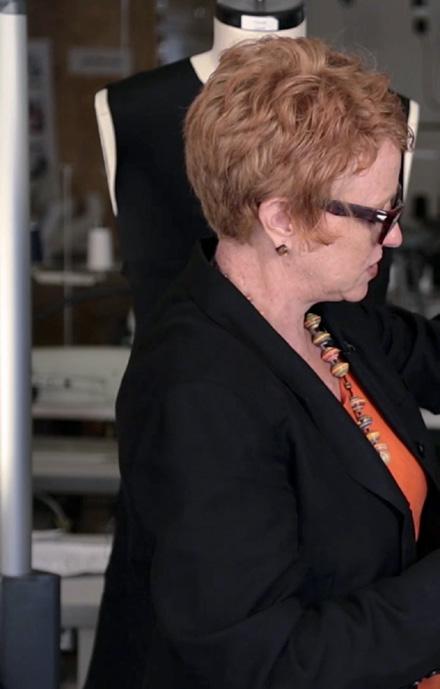
tions in all sorts of different aspects our lives,” says Dr. Mary ruppertStroescu, assistant professor of apparel design and textile science. “This project seamlessly integrates technology that monitors vital signs with our fabric to create a very wearable garment.” ruppert-Stroescu has developed the design of the garment, including selecting a fabric that is comfortable, creating a fit that is comfortable and natural to wear and creating ways for the garment to house the sensors.
“The smart garment integrates the sensor technology developed by our team right into the fabric,”
Want more details on the Health Smart g arment?
Scan this code to hear Mary r uppert-Stroescu and Brek Wilkins discuss the garment’s creation and potential uses. Video is also available by visiting ostate.tv/topics/research


24 Research at Oklahoma State University • www.research.okstate.edu
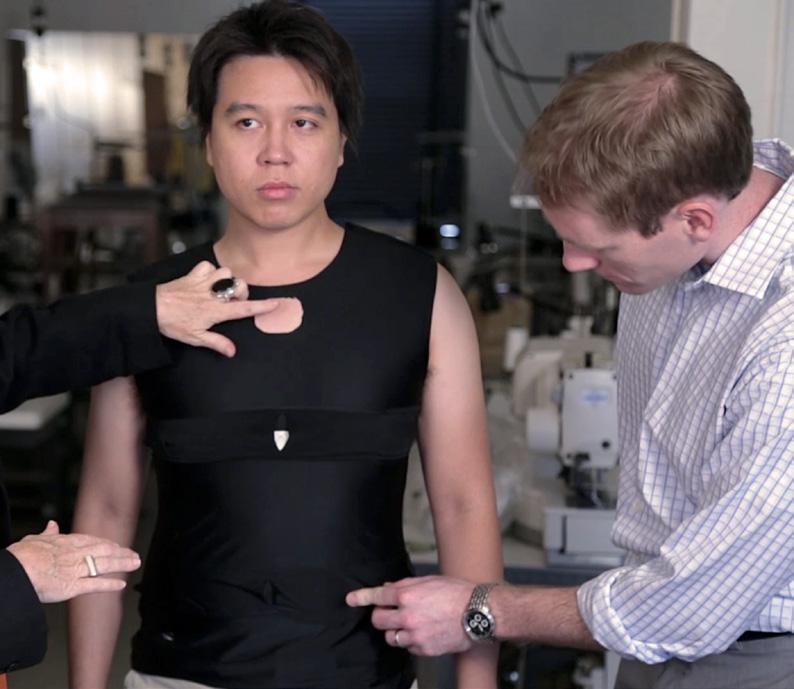
says ruppert-Stroescu. “We have strategically placed the electrodes, circuitry and circuit boards so they are easy to wear, and patients don’t end up tangled in wires and cords.”
Data could be collected and stored in the garment or transported wirelessly to a collection center from which a physician could download and analyze the signals.
While the garment could be used in diagnosing a number of diseases, the team decided to first focus on diagnosing sleep apnea.
“We chose sleep apnea as the first target entry point in the device market because the United States is experiencing a surge in the number of individuals with sleep disorder breathing and these individuals are not being screened for sleep apnea,” says Dr. Brek Wilkins, post-doctoral researcher at OSU-CHS. “About twenty-five percent of all Americans have sleep disorder breathing, but due to high (insurance) deductibles, long waiting times and in-clinic comfort levels, they won’t seek

treatment at a sleep study clinic.”
Wilkins says Smart Garments would allow patients to sleep comfortably in their own homes.
“ it would give individuals with possible sleep apnea an alternative path around the barriers to an in-clinic diagnosis,” he says.
in addition to the NSF grant, the team has also received a grant from the Oklahoma Center for the Advancement of Science and Technology to further develop the garment.
“These grant programs have really taken us outside of our research labs and helped us ask the right questions to the find the answers we needed to transition our technology from the lab and into the marketplace so we can help people,” says Wilkins. “Being in the marketplace accomplishes something just about every scientist wants to do — help people and have a technology that gets used by many.”
The Smart Garment project is an example of OSU researchers’
interdisciplinary approach toward scientific breakthroughs that can have a global impact.
“Our faculty are working together across disciplines to take an innovative approach to address common issues and come up with creative solutions,” says Howard Barnett, president of OSU-Tulsa and OSU Center for Health Sciences. “The smart garment project holds the key to revolutionizing the treatment of cardiovascular and respiratory diseases and disorders and is changing the way we think about patient care.”
While Benjamin leads the charge on the medical research, he stresses that the development of the Health Smart Garment would not have been possible without all the members of interdisciplinary research team.
“The project is so big that no one discipline, no one individual can actually solve the problem,” says Benjamin. “ you need the theoretical people who understand how the body works, the engineers who can take the ideas that we have and create the tools to monitor and interpret the signals from the body, and the design people who can create a garment that somebody would even decide to put on.”
While the team members are working to perfect the prototype for diagnosing sleep apnea, they are already looking at other ways to apply the technology.
“There is a lot of potential with this technology, whether it’s for critical care in hospitals or for patients in rural Oklahoma who don’t have access to the same resources that are available in larger communities,” says Benjamin. “This could potentially be used by everyone.”
SEA n KE nn EDy
25 Research at Oklahoma State University • www.research.okstate.edu
Dr. Mary ruppert-Stroescu, left, and Dr. Brek Wilkins adjust a prototype of the Health Smart Garment on patient model Woranat Wongdhamma.
Physics Medicine + = Success
OSU’s new medical physics graduate degree program serves students and the state

When Stephen Eller came to Oklahoma State University, he thought he wanted to be an engineer. “I’d always loved math and science,” says the student from Haskell. “I just thought engineering would be the best fit for me.”
However, toward the end of his bachelor’s degree Eller began having second thoughts. He had a relative, a sister-in-law, working in medical physics. Intrigued, he decided to find out what it was all about. He shadowed his sister-in-law’s boss, a medical physicist, for a summer.
He was hooked.
Eller took a nuclear engineering course the following fall semester and has never looked back. In August 2012, he completed his master’s degree in medical physics. He is the first student to graduate from OSU’s new medical physics graduate program.
“I really enjoyed learning the basic physics of radiation and the historical component to physics,” he says. “The historical perspective isn’t emphasized in engineering. I also enjoyed learning
more about the fundamentals of matter, which is what physics is all about.”
Medical physics is a branch of physics dedicated to radiotherapy and diagnostic imaging. Most commonly associated with cancer treatment, many medical physicists work in hospitals alongside nurses and oncologists to design and develop radiation treatment plans for patients. They also conduct research and play a vital role in ensuring radiation equipment, such as X-ray machines and linear accelerators, work properly.
“People don’t normally think of a physicist working in a hospital, but they really have a very important job in a hospital setting: Making sure that radiation is administered appropriately,” Eller says. “Radiation mis-administered has serious consequences, so there has to be someone between the oncologist and the therapist who understands how the equipment works and can try to prevent those kinds of errors.”
History of medical physics
The melding of physics with medicine isn’t new. In fact, it traces all the
way back to the discovery of X-rays by physicist Wilhelm Conrad Roentgen in 1895. The application of these rays to medical imaging was recognized and embraced immediately. When the Nobel Prizes were established at the turn of the century, Roentgen won the first prize in physics for his discovery.
Over the last 50 years, physicists have continued to impact medicine and win Nobel Prizes for doing so. Felix Bloch and Edward M. Purcell shared the Nobel Prize in Physics in 1952 for the discovery of magnetic resonance, which led to the development of the MRI routinely used today to image the human body. In 1979, Allen McCormack and Geoffrey Newbold Hounsfield won the Nobel Prize in Physiology or Medicine for developing computerized tomography, which has revolutionized imaging due to its ability to provide images with unprecedented clarity.
Most recently, physicists have spearheaded the development and application of linear accelerators for cancer treatment. Once confined only to physics laboratories, these
26 Research at Oklahoma State University • www.research.okstate.edu
sophisticated, high-energy machines can deliver beams of energetic electrons or X-rays to malignant tumors at doses capable of killing cancerous cells and stopping a tumor’s growth.
“Going back to the discovery of the X-ray, there’s been a large collaboration between physics and medicine,” says Jerimy Polf, assistant physics professor and coordinator of the medical physics program at OSU. Polf is a board-certified medical physicist who worked at M.D. Anderson in Houston before he returned to his alma mater to teach and help launch the graduate program.
Medical physics research at OSU
Although it might not lead to discoveries as revolutionary as the X-ray or developments as monumental as the CT scan, Polf and students like Eller are involved in research they believe will make an impact. One project, a collaboration with scientists at OSU’s Center for Veterinary Health Sciences, evaluates new ways of using nanoparticles to improve cancer treatments. Polf calls the project basic science, and says they’re just working with cells in a petri dish. However, the hope is that it will translate into new clinical treatment methods.
“All the major medical physics discoveries started out as basic science stuff in the lab that translated into the clinic and the hospitals,” he said.
In another project, Polf and students are developing detectors and methods to image the radiation beam and where it is in the body during a radiation treatment. This project is a collaboration with the M.D. Anderson Cancer Center and funded by the National Institutes of Health. It has a large potential for impact, Polf says, especially because it also provides an image of the elemental composition of the tumor – information that can be provided to the physician to determine how the tumor responds to treatment and whether or not the treatment plan should be modified.
As part of his master’s program, Eller’s research focused on a new application of a standard radiation detection crystal, aluminum oxide. The ultimate goal was to develop more reliable and
convenient ways of measuring radiation delivered to patients by starting with understanding the material’s physics. Attached to patients’ skin while they receive radiation treatment, the small crystal detectors can be read to confirm the appropriate amount of radiation was given during a treatment session. His work was funded by Landauer, a global leader in integrated radiation safety products and services.
In addition to research, the OSU medical physics graduate degree program includes course work and clinical rotations at partner facilities such as Hillcrest and St. John’s medical centers in Tulsa and the ProCure Proton Therapy Center in Oklahoma City.
“We are very grateful for partners like Hillcrest and ProCure, who provide our students with a level of handson experience unavailable through the classroom and the lab,” Polf says.
an industry where you have to know and understand the fundamentals, but at the end of the day you get to apply that information in a way that has a substantial impact on the lives of others.”
The program is the physics department’s response to OSU’s land-grant mission, says Eric Benton, another physics professor working with students in the program. “Oklahoma is a culture of people who want to do things,” Benton says. “And we are passionate about helping people. That’s what makes this program so great and why our students enjoy it.”
Eller has begun a doctoral program in physics at OSU, an effort requiring about three more years of study and research. Once he has finished, he would like to work in a hospital while maintaining an active research agenda.
According to the American Association of Physicists in Medicine,

“People don’t normally think of a physicist working in a hospital, but they really have a very important job in a hospital setting: making sure that the use of radiation is administered appropriately.”
– Stephen Eller
Impact
Eller says practical, hands-on application and the ability to help people is really what sold him on medical physics.
“Medical physics is unique in the sense that you really have to understand the building blocks of matter, and you get to apply that to something as practical as treatment of cancer,” he says. “It’s
the U.S. needs at least 200 new medical physicists per year by 2030 to offset the growing incidences of cancer and the retirement of medical physicists from the baby boomer generation. OSU’s program is one of about 25 others in the nation.
K E lly G REE n
27 Research at Oklahoma State University • www.research.okstate.edu
PHOTO / KEVIN MCCROSKEY
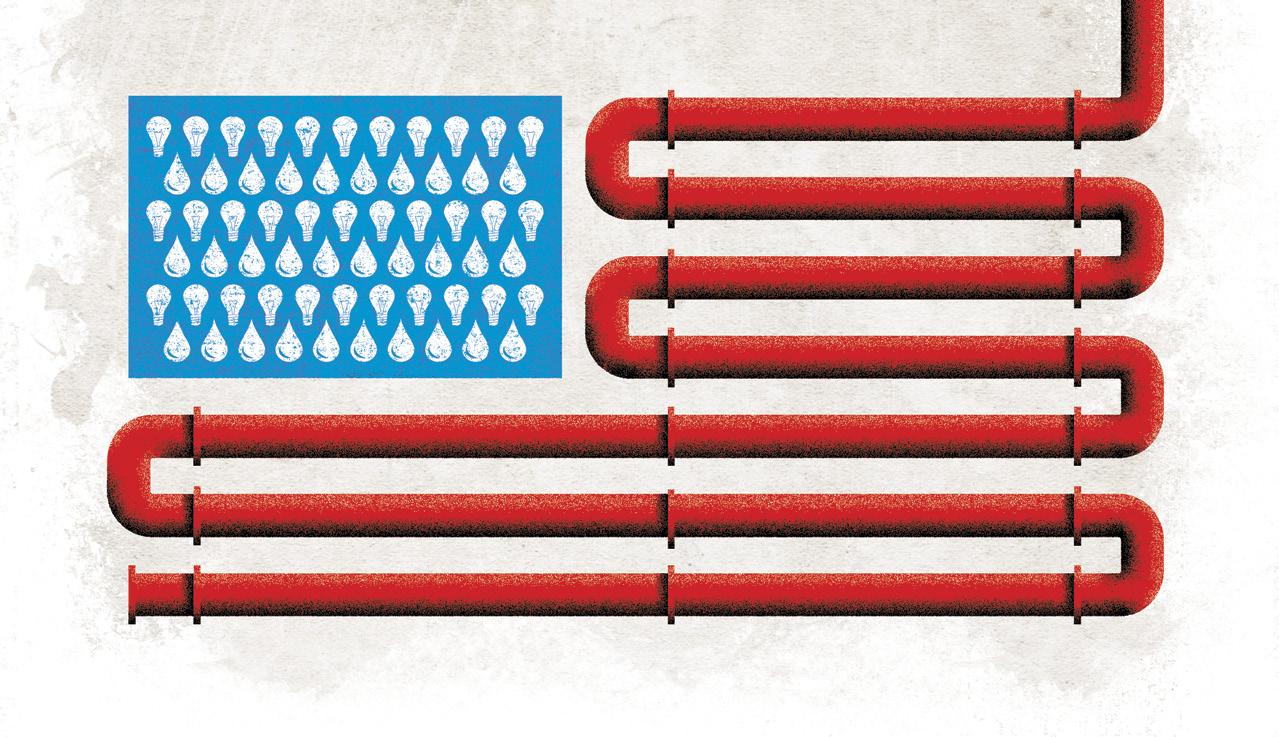
The Energy Renaissance and U.S. Energy Policy
BY BETTY SIMKINS
The shock of the 1970s oil price increases awakened the U.S. to the risk of uncertain energy supply and the importance of energy to economic development. Fast forward to 2012 – the U.S. is now undergoing a shock of a different type, an energy renaissance, resulting in dramatic increases in crude oil and natural gas supply.
The latest projections of U.S. energy needs in the year 2035 by the Energy Information Administration indicate that oil, natural gas and coal should still dominate the energy mix by providing 77 percent of our energy needs, as compared to 83 percent in 2010. Renewable energy is expected to grow from 8 percent in 2010 to 14 percent by 2035. The good news is that having an increasing supply of crude oil and natural gas helps give us time to do the research and development necessary
to make our next energy transition. It took the U.S. almost a century to build the system we have today, transporting oil and gas efficiently throughout our country. It can easily take a similar time period to build new systems that take advantage of future energy sources. It is still unclear what the primary energy sources will be when we shift from our current mix of fossil fuels.
We must face the hard facts about energy. These hard facts are what I refer to as the following five energy realities, all of which have important implications for energy policy.
Energy Reality One: We are not running out of fossil fuels.
The U.S. is undergoing an energy renaissance and is at a historic turning point involving domestic production growth for the two fossil fuels: crude oil and natural gas. Advances in horizontal drilling and hydraulic fracturing
have made it possible to recover oil and natural gas from shale and tight formations in an economical way that was previously not possible. These technological advances in drilling and production from unconventional formations are a paradigm-shifter that is still evolving and will effect not only the U.S., but also global markets. To put it simply, the world is not running out of oil or natural gas anytime soon, and peak oil is nowhere in sight. This has also stimulated a rebirth of the U.S. petrochemical industry and will enable the U.S. to become one of the lowest cost producers of chemical feedstocks such as ethylene.
Energy Reality Two: Energy transitions can take close to a century.
This time period has been referred to as the “Age of Hydrocarbon Man” because our civilization is based on the use of fossil fuels or hydrocarbons. This
28 Research at Oklahoma State University • www.research.okstate.edu
age will probably last another 50 to 100 years, if not longer. Energy transitions do not happen quickly, and with past transitions, we have always moved to a more convenient and economic fuel. In the 1800s, the U.S. shifted from wood to coal. While the modern petroleum age began in 1859 when the first oil well was drilled in Pennsylvania, oil would not topple king coal as a major energy source in the U.S. until the late 1940s. This transition took over 80 years. A challenge for renewables is that, for the first time in the history of the U.S., we would be attempting to move to an energy source that is less useful and less convenient, as compared to fossil fuels. Will one of the current renewable energy sources be the primary fuel of the future? This topic will be discussed in the next energy reality.
Energy Reality Three: Energy is all about thermodynamics and financial economics.
Thermodynamics determines how much energy we can get from various sources and is based on the atomic constitution of matter. We cannot change this. The optimal energy source is the one that provides the highest energy density (i.e., highest energy stored per volume or weight) in the most economic way – that is, the biggest bang for the buck. Liquid hydrocarbons have very high energy density whereas renewable sources have a much lower energy density.
Renewable energy sources such as wind and solar, while certainly important, will not be able to provide the scale of energy our country needs. Because they are intermittent, require large land footprints and are less economical, they will remain small players in our energy future. When it comes to nuclear energy, let’s not throw out the baby with the bath water. Nuclear energy has a high energy density, relatively low cost and low carbon impact. We know from financial economics that markets should ultimately determine the sources of energy, how much gets used and where it is used. Government’s role should be to set reasonable standards for environmental performance, but not to force solutions that may never be economically competitive.
Energy Reality Four: Energy security is what we really want.
Energy independence is a misnomer because the name implies we are isolationists. That is not what we want in the U.S. We live in increasingly interdependent global markets. Oil security does not insulate the U.S. from global oil prices and markets because oil is a globally traded commodity impacted by supply, demand and geopolitics. In 2011, the U.S. exported more gasoline, diesel and other fuels than it imported for the first time since 1949. Likewise, the U.S. is expected to be an exporter of liquefied natural gas within the next few years. This will help to balance U.S. trade and create more jobs.
Energy Reality Five: The public is misinformed about energy and energy education is a must.
Recent surveys in the U.S. show that the public is woefully undereducated, and in some cases energy illiterate, about the facts and economics of energy. This is indeed unfortunate. For example, when asked about what drives energy prices, the public had it exactly backwards and did not realize that supply and demand for oil, natural gas and electricity are the most important determinants of energy prices. It is disappointing that politicians, regardless of their party affiliation, take advantage of the public’s lack of knowledge and slant information in ways that reinforce misperceptions. This is due to the fact that politicians want to pander to their constituencies and get votes. Our education system needs to do a better job of educating the public, not just college students, on energy policy because democracy requires an educated, voting public. A political process that encourages misinformation is undesirable.
No matter what, alternative energy sources have big shoes to fill. We do not know what the fuel of the future will be yet – whether it is a combination of the alternatives we are currently developing
or a completely new source of energy. Daniel Yergin forecasts that higher oil prices will produce “a great bubbling of innovation” across the energy spectrum. There may be a game changer out there we have not even envisioned yet.
Overall, our country needs an energy policy that promotes all of our energy resources and encourages investment in advanced technologies. These measures will help create jobs, strengthen our economy and enhance energy security. Through the National Energy Solutions Institute, a collaborative effort at OSU, our university can be a leader in these endeavors through energy research and education. NESI fuses the needs of private industry in energy production, distribution and conservation with practical and impactful academic research. NESI research provides energy solutions for the current and future needs of the nation as OSU scientists work in collaboration with private, state and federal sectors to enable the nation’s transition to a sustainable energy future.
NESI also emphasizes education and training in order to supply the state and nation with the educated workforce needed to advance energy technology, policy and economics. In addition, NESI acts as a focus for outreach activities to provide topical and relevant information to policy makers and technologists to enable the growth of sustainable energy enterprises in the modern world.
By being a thought leader, OSU can help develop energy policy recommendations that will ensure that not only Oklahoma, but the U.S. as a whole, makes correct energy policy decisions for a prosperous future. We are at the cusp of an energy revival. Our country’s energy future is very bright, and OSU needs to be a leader in new technologies to help meet our future energy needs. We cannot be passive. We must take a proactive stance.

29 Research at Oklahoma State University • www.research.okstate.edu
B ETTY Si MK in S is Williams Companies professor of business and professor of finance in the Spears School of Business. She also serves as director of NES i ’s Energy Policy Center.

Canna lilies
PHOTOS BY KEVIN MCCROSKEY
Plants in Possibilities The
Discovering her interest for science at an early age, Dr. Jeanmarie Verchot found herself in love with biology. Now at a milestone in her career, that interest has not changed.
As an associate professor in the department of entomology and plant pathology at Oklahoma State University, her research has always included tissue culture in a strategy to control diseases in agriculture. During her career, she has looked at everything from carrots and celery to tobacco, corn and wheat, but her current efforts focus on one of the world’s most widespread landscape plant: canna lilies. She focuses on perfecting the method of tissue culture that converts virus-carrying canna lily tissues
Cowboy Technologies helps propel OSU start-ups to success
As the final step in a commercialization program developed to successfully transition ideas from the lab to the marketplace, Oklahoma State University’s Cowboy Technologies LLC is nurturing faculty inventions to commercial success.
Associated Material Processing, one of Cowboy Technologies’ first startups, focuses on removing arsenic from water. AMP’s mission is to make safer drinking water supplies and rehabilitate wastewater from manufacturing processes such as computer chip-making.
Cowboy Technologies is also working with the Creativity, Innovation and Entrepreneurship Scholars program through the Spears School of Business, corporate sponsor AAA Oklahoma and the Office of the Vice President for
Research and Technology Transfer to launch an App Center at OSU. The center will provide a space where students can transition their app ideas into functioning Web and mobile applications.
As a funding source for these initiatives and others, Cowboy Technologies has established CT Angels. A member-led investment fund comprised of OSU alumni and supporters, it allows member investors to have a first look at technologies developed at OSU and to invest in those technologies to help them reach commercialization. CT Angels is seeking new OSU enthusiasts and friends to invest in the technologies developed at OSU.
For more information about faculty projects, the App Center or CT Angels, visit www.cowboytechllc.com
to virus-free canna lilies. It’s a method that could have a substantial impact on our state, with Oklahoma being one of the world’s largest producers of canna lilies. Horticulture is also the fifth-largest industry in the state.
Canna plants infected with viruses have streaks or breaks in flower color. Oklahoma growers, lacking proper diagnostic tools and techniques, are often unaware of the nature of the viruses. This problem costs Oklahoma’s floral industry more than $155 million a year.
Canna lilies are more than ornamental plants. They can be used as an edible starch and have medicinal value in treating a number of diseases, including hepatitis.
Verchot’s work poses so many possible benefits for growers and the state that Cowboy Technologies, a for-profit, limited liability company that aims to commercialize university inventions, is working with her to ultimately deliver certified virus-free canna lily plants to growers in Oklahoma and beyond.
The Road Toward Success
Verchot graduated with a bachelor’s degree in genetics from Rutgers University. During her studies, she held internships at Roche Biomedical and at DNA Plant Technology, where she learned the value of tissue culture production.
After the internship at Roche Biomedical, which included pediatric genetic screening, Verchot briefly considered becoming a genetic counselor. However, she ended up deciding that field wasn’t a good fit for her.
“I realized that job was not really pleasant,” she says, adding with a smile: “It seemed repetitive, and I do not like needles.”
30 Research at Oklahoma State University • www.research.okstate.edu
Instead, she looked to the possibilities in plants.
Taking the DNA Plant Technology internship may have paid little in salary but it definitely offered “a long-term gain,” Verchot says. “In those days, internships in biotechnology were rare … [but] the experience was really enjoyable.”
“The company is no longer in existence,” says Verchot. “However, the experience was life-changing because I learned that I loved plant biology.”
Working side-by-side with scientists at DNA Plant Technology, which partnered with Campbell Soup, Verchot helped engineer more flavorful vegetables for soups using tissue culture to enrich them.
Verchot also worked in industry. She worked for a small start-up company in ag biotechnology after she graduated from Rutgers. She then went back to school for a doctorate at Texas A&M University and a post-doctoral appointment at Sainsbury Laboratory in the United Kingdom.
“In all my projects, we have always used tissue culture for research and for understanding fundamental processes,” Verchot says. “Tissue culture is always the basis for engineering and for understanding biological processes. In my work, we look at viruses and understanding virus life cycles, as well as trying to develop strategies to control viruses. [Tissue culture is] a pervasive tool as well as a product.”
Bringing that experience with her to the Noble Research Center at OSU, Verchot first dived into experiments with wheat and what improvements could help Oklahoma’s farmers.
“It has always been a broad project. Our goal is to meet the needs of the state,” says Verchot. “I have always been looking for opportunities to help. The project with canna lilies came up, and it seemed like there was a real need and a real solvable problem. It seemed like the natural way to go.”
The state agreed. With support from the Oklahoma Center for the Advancement of Science and Technology and Horn Canna Farms, the largest wholesaler of canna lilies in the nation, Verchot went to work. She soon proved that virus-free canna lilies could
be produced by micro-propagation of embryo and shoot tip cultures.
“The value of tissue culture production has been in the back of my mind through my career, and it has been a major influence in establishing VF Canna,” says Verchot about the company she’s established through OSU’s Cowboy Technologies to commercialize her research. “There are some issues that we felt we could contribute to the production in helping growers to support the industry.”
The Path to Commercialization
Cowboy Technologies was organized in 2011. The company’s goals reflect Oklahoma State University’s land-grant mission of taking university research from the campus to the community.
“The best way to move forward is through commercialization, where we can work more closely with private sectors to expand our services,” says Verchot. “I had an opportunity to present to Cowboy Technologies through the Technology Business Development Program. They select ideas on which they feel they could work with, and VF Canna was selected.”
nologies’ chief executive officer. “The process we’ve established at OSU is designed to identify and foster projects, like hers, that are based on sound science, are economically viable and stand to benefit not only Oklahoma but the world.”
The partnership with Horn Canna Farms takes place at the Ridge Road greenhouse facilities at OSU. Horn provides planting, harvesting and weed control; in return, it is anticipated that Horn will receive an exclusive right to the commercial bulb market.
Every growing season, VF Canna will screen plants from Horn for certification and sale. During the screening process,
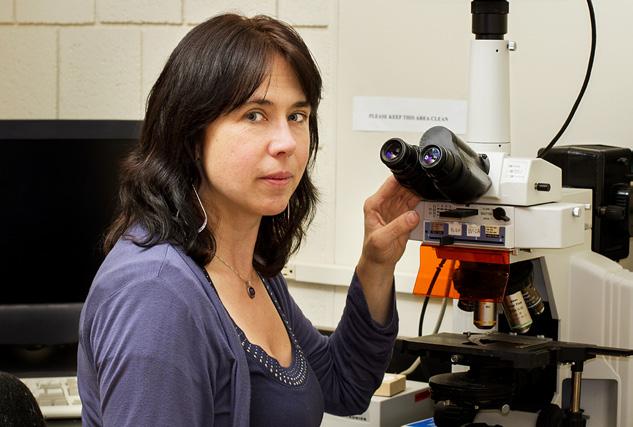
Cowboy Technologies identifies technologies of commercial interest and creates an initial business model. The model is presented to Cowboy Technologies’ advisory committee for review before its board makes a final funding decision. Once a business model is approved, Cowboy Technologies acts as interim management for the commercialization of the project until an industry-specific management team is formed. Cowboy Technologies handles the initial product and business development and sources co-funding partners for each stage of development.
“We are excited to be working with Jeanmarie to commercialize her technology,” says Steve Wood, Cowboy Tech-
the plants with no detectable virus will be identified and certified. Horn is a master distributor, which allows VF Canna’s certified virus-free canna bulbs to immediately go to the wholesale market. Bulbs will also be planted in the field in order to bulk up the supply and sold as individual container plants to nurseries and direct consumers.
Wood says VF Canna proves the technology commercialization ecosystem at OSU is functioning.
“OSU has worked for a while now to establish and refine a process that not only supports but also encourages the commercialization of research of benefit to our community,” he says. “This project is one great example of the effectiveness of that process. It’s a win for all parties involved.”
DAVID P URDIE
31 Research at Oklahoma State University • www.research.okstate.edu
Jeanmarie Verchot has perfected a method of tissue culture that results in certified virus-free canna lilies.

Yan named 2012 OSU Whatley Award recipient
Oklahoma State University’s Liuling Yan has been named the 2012 recipient of the James A. Whatley Award for Meritorious Service in Agricultural Sciences.
The award was initiated in 1982. It is presented annually to the top young scientist in OSU’s Division of Agricultural Sciences and Natural Resources.
An OSU faculty member since 2006, Yan holds the Dillon and Lois Hodges Professorship in the department of plant and soil sciences.
“Dr. Yan’s research has brought unprecedented attention to OSU and conferred a higher reputation on its Wheat Improvement Team than would be attainable in his absence,” says Brett Carver, OSU Regents professor and holder of the university’s Wheat Genetics Chair in Agriculture.
Carver says Yan’s scientific discoveries are transforming wheat improvement programs in the public and private sectors.
“Reproductive differences in winter wheat, which Dr. Yan has addressed throughout his OSU career working on Oklahoma’s commercial plant — hexaploid wheat — are exponentially more diffi-
cult to dissect genetically than differences between spring and winter wheat,” he says.
Yan was the first to locate four genes, and to develop the corresponding gene markers for their detection, that regulate reproductive development in winter wheat. His discoveries have directly allowed the OSU Wheat Improvement Team to manipulate the vegetative period and forage biomass consumed by beef cattle on wheat pasture.
Mark Hodges, executive director of Plains Grains Inc., was one of many to write letters of nomination for Yan.
“Wheat and its associated grazing component are worth in excess of $1.5 billion annually to the Oklahoma economy,” Hodges says. “These numbers, coupled with the support and belief that Oklahoma producers have in OSU’s wheat breeding program, showcase the importance of his contributions to our agricultural industry.”
Yan also was the first to find a robust genetic marker system for detecting key defense genes for protection against two of the most damaging diseases worldwide in wheat: leaf rust and stripe rust.
“Dr. Yan is rapidly gaining recognition as a national and international authority in wheat genetics,” says Dave Porter, head of the OSU department of plant and soil sciences. “His research has proven to be especially important for Oklahoma’s dual-purpose grain and grazing wheat production system; one extra week of grazing can generate an additional $3 to $4 per acre for producers, which adds up and may mean the difference between profit and loss.”
Yan’s research contributions are evidenced by his obtaining more than $1 million in direct grants since arriving at OSU in 2006, part of more than $30 million in grants attracted to the division in which his research has been a contributor, from such agencies as the U.S. Department of Agriculture, Oklahoma Wheat Commission and Oklahoma Center for the Advancement of Science and Technology, among others.
He has received more than 1,500 citations in ISI Web of Science for publications as the first or corresponding author and 600 citations for publications he has co-authored.
Yan currently serves as the major academic adviser to four graduate students and as supervisor of three postdoctoral research associates and two visiting scientists.
Prior to joining OSU, Yan served on the staffs of the University of California at Davis, University of Melbourne and Yangzhou University in China.
He earned his bachelor’s degree in agronomy and his master’s in wheat physiology from Yangzhou University in 1984 and 1987, respectively. Yan earned his doctorate in plant molecular genetics from Australia’s Victoria University in 2000.
Whatley, in whose name the award is presented, was an animal geneticist who became director of the Oklahoma Agricultural Experiment Station and then dean of the division, which is comprised of the College of Agricultural Sciences and Natural Resources and two statewide agencies: the Oklahoma Cooperative Extension Service and Oklahoma Agricultural Experiment Station system. Whatley served OSU for 41 years.
D O n StOtt S
32 Research at Oklahoma State University • www.research.okstate.edu
Liuling Yan, an associate professor in wheat molecular genetics, has been named the 2012 recipient of the James A. Whatley Award for Meritorious Service in Agricultural Sciences.
PHOTO / TODD JOHNSON
Growing the Numbers
Research at Oklahoma State University • www.research.okstate.edu $200 $180 $160 $140 $120 $100 $80 $60 $40 $20 $0 ’02 ’03 ANNUAL RESEARCH EXPENDITURES IN MILLIONS OF DOLLARS ’04 ’05 ’06 ’07 ’08 ’09 ’10 ’11 ’12
10 8 6 4 2 0 NUMBER OF PATENTS GRANTED ’02 ’03 ’04 ’05 ’06 ’07 ’08 ’09 ’10 ’11 ’12 $2.0 $1.75 $1.5 $1.25 $1.0 $.75 $.5 $.25 $0 INCOME FROM LICENSES (IN MILLIONS OF DOLLARS) ’02 ’03 ’04 ’05 ’06 ’07 ’08 ’09 ’10 ’11 ’12 45 40 35 30 25 20 15 10 5 0 NUMBER OF LICENSES YIELDING INCOME ’02 ’03 ’04 ’05 ’06 ’07 ’08 ’09 ’10 ’11 ’12
Annual Research Expenditures (2002 – 2012) Intellectual Property (2002 – 2012)
33
Images frozen in time
When art historian Jennifer Borland looks at art, she asks questions that might not occur to the rest of us: How would a viewer from this time period interpret this? How would people have applied this to their everyday lives? Given her field of art history, she’s as concerned with the piece’s impact on society as much as she is with the object itself.
Specializing in medieval art, Borland is currently examining a popular illustrated health guide known as the Régime du corps. She is working with several different illustrated copies of the guide, including three from the late 13th or early 14th centuries, which are located at libraries in France and the United Kingdom. The text itself survives in more than 70 copies. “For a single text to survive in that many copies today means it was very popular at the time,” she says.
Borland hypothesizes that the guide was written for and used primarily by affluent women. It seems the text was originally written by Aldobrandino of Siena, the personal physician of Béatrix of Savoy, the countess of Provence. A prologue that appears in several copies of the book states that the guide was initially written for her to give to her four daughters, all of them European queens.
As the guide was reproduced and survived the generations, Borland believes it was used by the matriarch of a family to manage the health of the household — not just her own children, but potentially servants and their chil-
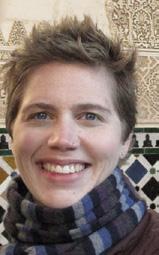
Borland

dren as well. The guide features sections on childcare, hygiene, drawing blood, leeching — the act of placing leeches on the body to remove toxins — breathing clean air and avoiding illness.
“At this time, much of the medical profession was becoming more institutionalized and medical study was moving to universities,” Borland points out. “But to see this kind of medical compendium created for use in the domestic realm as well suggests that such medical knowledge was not limited to the academic setting or to male physicians.”
It’s a very exciting journey of discovery for Borland, who has traveled to France and the U.K. to examine the manuscripts in person, thanks to
funding from the Oklahoma Humanities Council and the OSU College of Arts and Sciences. She’s already given several lectures about this project and has completed an article as well. She also plans to make the work the subject of a book, to be entitled Domesticating Medical Knowledge: Household Health and the Late Medieval Illustrated
Manuscripts of the Régime du corps
Borland is an assistant professor of art at OSU. She obtained her bachelor’s degree from the University of Pennsylvania and her master’s and doctorate from Stanford University.
For more information on Borland and her work, visit art.okstate.edu/ faculty/borland.php.
Non-Profit U.S. Postage PAID Stillwater, OK Permit #191 Oklahoma State University Office of Vice President for research and Technology Transfer 203 Whitehurst Stillwater, OK 74078-1020
KE lly GREE n
Woman and physician, detail from early 14th-century copy of the Régime du corps © British Library Board (Sloane MS 2435, fol. 27v)
















































